Chinese New Year Decorations
Where Do Orthodox Come From?
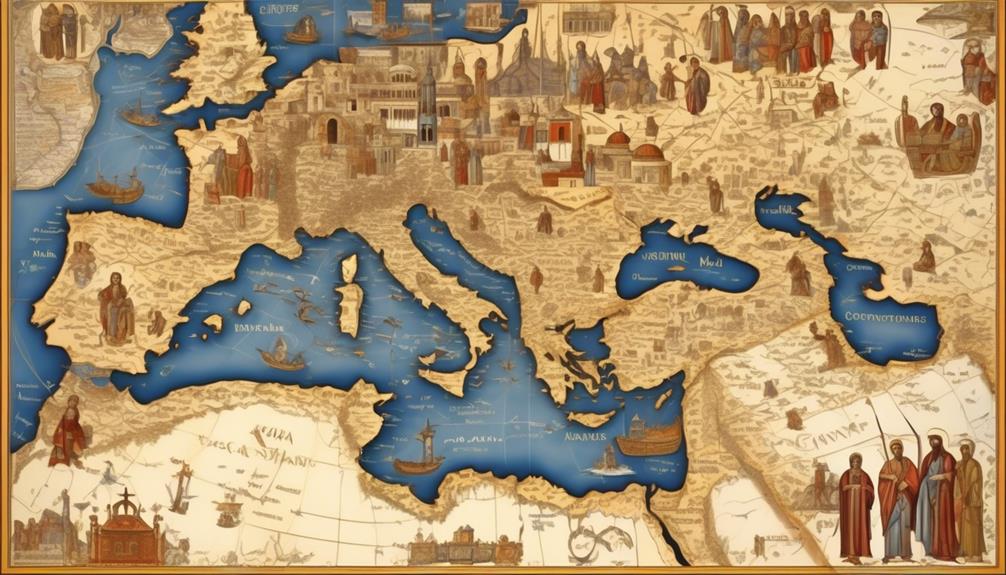
Have you ever wondered about the origins of the Orthodox Church? While some theories suggest that it began with the very early Christian Church, the truth is far more complex and fascinating.
The history of Orthodoxy is intertwined with significant events and developments that have shaped the faith in profound ways. Exploring these origins can provide valuable insights into the rich and diverse traditions of the Orthodox Church, shedding light on its enduring significance in the modern world.
Key Takeaways
- Orthodox Christianity has its origins in the early Christian Church and claims to have an unbroken transmission of authority and a direct link to the Apostles through apostolic succession.
- The Byzantine Empire played a significant role in the development and influence of Orthodox Christianity, through its art, theologians, liturgy, and the endorsement and protection of the faith by Byzantine emperors.
- The Great Schism of 1054 AD resulted in a split between the Eastern Orthodox Church and the Roman Catholic Church, primarily due to theological disagreements, cultural and linguistic factors, questions of ecclesiastical authority, and variations in liturgical practices.
- Byzantine art and architecture had a profound influence on Orthodox culture and religious practices, particularly through the use of iconography and iconic religious imagery, which inspired the construction of Orthodox churches and influenced liturgical art within the tradition.
Early Christian Church
The Early Christian Church emerged as a community of believers following the teachings of Jesus Christ and laying the foundation for the development of Orthodox Christianity. Our early church was deeply rooted in the apostolic tradition, where the teachings and practices were passed down from the apostles who personally knew Jesus. It was a time of great fervor and devotion, as believers gathered in homes and secret locations to worship and share the teachings of Jesus.
In those formative years, our faith was a source of great comfort and strength, especially in the face of persecution. We found solace in coming together as a community, supporting one another through the challenges of living out our beliefs in a society that often misunderstood or opposed us. Our gatherings were marked by a sense of intimacy and shared purpose, as we sought to embody the teachings of Jesus in our daily lives.
The apostolic tradition provided a solid framework for our beliefs and practices, shaping the early church into a vibrant and resilient community. It laid the groundwork for the development of Orthodox Christianity, setting the stage for the rich theological and spiritual heritage that continues to guide us today.
Apostolic Succession

Let's talk about the historical lineage of bishops and the unbroken transmission of authority within the Orthodox Church.
This lineage serves as a direct link to the apostles, forming the foundation of apostolic succession.
Understanding this crucial aspect sheds light on the continuity and authenticity of Orthodox teachings and traditions.
Historical Lineage of Bishops
Throughout the centuries, the historical lineage of bishops, also known as Apostolic Succession, has been carefully preserved and passed down within the Orthodox Church. This unbroken chain of spiritual authority can be traced back to the apostles themselves, ensuring a direct link to the teachings and practices of early Christianity.
The lineage of bishops represents a sacred connection to the foundation of the Church, embodying the continuation of divine grace and spiritual guidance. As the early Christian community evolved and spread, the establishment of bishops as overseers and spiritual leaders became fundamental to maintaining doctrinal purity and unity.
Today, this historical lineage of bishops remains a cornerstone of Orthodox faith, providing a tangible connection to the origins of the Church and serving as a testament to the enduring presence of God's grace throughout history.
Unbroken Transmission of Authority
Preserving and transmitting unbroken spiritual authority, Apostolic Succession forms a crucial link between contemporary Orthodox leadership and the teachings of the early apostles. This unbroken lineage of apostolic authority ensures that the spiritual and doctrinal guidance provided by today's Orthodox leaders is directly connected to the teachings of the apostles themselves. Through Apostolic Succession, we're connected to the early Church in a tangible and unbroken way, allowing us to draw on the wisdom and truths passed down through generations.
Apostolic Succession guarantees the continuity of spiritual authority. It provides a direct link to the teachings and practices of the apostles. This unbroken lineage instills confidence in the authenticity of Orthodox leadership. Apostolic Succession serves as a foundational element of Orthodox faith and practice.
Link to the Apostles
Ensuring the continuity of spiritual authority, Apostolic Succession provides a direct and unbroken link to the teachings and practices of the apostles, instilling confidence in the authenticity of Orthodox leadership.
This unbroken chain of apostolic authority has deep historical roots, tracing back to the earliest days of the Church. The concept of Apostolic succession is crucial in maintaining the spiritual integrity of the Orthodox faith, as it connects us directly to the early church and the apostles.
Ecumenical Councils
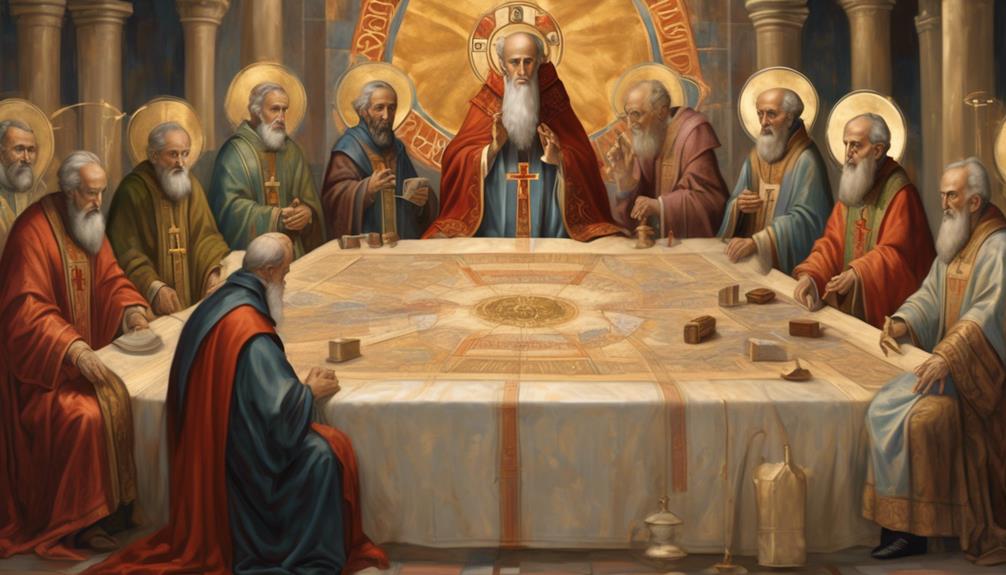
The Ecumenical Councils played a crucial role in shaping the beliefs and practices of the Orthodox Church. These councils, convened by the early church, addressed theological debates and made doctrinal decisions that continue to influence Orthodox Christianity to this day. As we explore the impact of Ecumenical Councils, it's important to highlight:
- Nicaea I (325): Here, the Nicene Creed was formulated, affirming the divinity of Christ and establishing the foundation for Orthodox beliefs about the Trinity.
- Constantinople I (381): This council affirmed the Nicene Creed and expanded on the divinity of the Holy Spirit, shaping the Orthodox understanding of the Trinity.
- Ephesus (431): The council addressed the nature of Christ, affirming the belief in the union of divine and human natures in Christ, which is central to Orthodox Christology.
- Chalcedon (451): This council clarified the relationship between the divine and human natures of Christ, leading to the formulation of the Chalcedonian Definition, which remains a cornerstone of Orthodox Christological doctrine.
These councils not only defined key aspects of Orthodox theology but also fostered unity and consensus among the early Christian communities.
Byzantine Empire

The Byzantine Empire had a significant impact on the development of Orthodox Christianity. Its influence on the formation of Orthodox liturgy and the spread of Orthodox beliefs are key aspects to consider.
Understanding the role of the Byzantine Empire in shaping Orthodox traditions provides valuable insights into the origins of the faith.
Byzantine Influence on Orthodoxy
Influencing the development of Orthodox Christianity, the Byzantine Empire left a lasting impact on the faith through its cultural, political, and theological contributions.
The Byzantine Empire significantly shaped Orthodoxy through:
- Byzantine art: Iconography and mosaics adorned churches, conveying theological truths and shaping the faithful's spiritual understanding.
- Theological influence: Byzantine theologians, such as Gregory of Nyssa and John Chrysostom, contributed to the formation of Orthodox doctrinal beliefs and practices.
- Liturgical tradition: The Byzantine Empire played a pivotal role in the development of the Orthodox liturgical calendar, hymnography, and worship practices.
- Political support: Byzantine emperors often endorsed and protected Orthodox Christianity, solidifying its place as the state religion and influencing its theological and ecclesiastical structures.
The Byzantine Empire's influence continues to resonate in Orthodox Christianity, enriching its traditions and theological heritage.
Development of Orthodox Liturgy
Enriching our understanding of the Byzantine Empire's impact on Orthodox Christianity, the development of Orthodox liturgy reflects the intricate fusion of cultural, theological, and political influences.
The liturgical evolution within the Byzantine Empire wasn't only a reflection of religious beliefs but also a result of cultural adaptation. The influence on worship and spiritual significance was profound, shaping the Orthodox liturgy into a rich tapestry of traditions, prayers, and rituals.
The Byzantine Empire's embrace of diverse cultural elements, such as language, music, and art, greatly influenced the development of Orthodox liturgy, creating a unique and deeply meaningful religious experience.
The spiritual significance of these liturgical practices was intertwined with the empire's political and theological landscape, making the Orthodox liturgy a central aspect of Byzantine religious life.
Great Schism

Emerging tensions and theological differences between the Eastern and Western Christian churches ultimately led to the Great Schism. This pivotal event in Christian history occurred in 1054 AD and resulted in the permanent division of the Church into the Eastern Orthodox and Roman Catholic traditions. The Great Schism wasn't a sudden rupture, but rather the culmination of longstanding disagreements and cultural divisions between the two branches of Christianity.
- Doctrinal Disputes: The Great Schism was fueled by disagreements over theology, such as the filioque clause in the Nicene Creed and differing views on the authority of the pope.
- Cultural and Linguistic Factors: The divide was also influenced by cultural and linguistic disparities between the Greek-speaking East and the Latin-speaking West.
- Ecclesiastical Authority: The question of authority within the Church, particularly the authority of the bishop of Rome, played a significant role in the schism.
- Liturgical Practices: Variances in liturgical practices and customs further contributed to the growing rift between the Eastern and Western churches.
The Great Schism left a lasting impact on the trajectory of Christianity, shaping the distinct theological, cultural, and ecclesiastical identities of the Eastern Orthodox and Roman Catholic traditions.
Byzantine Influence
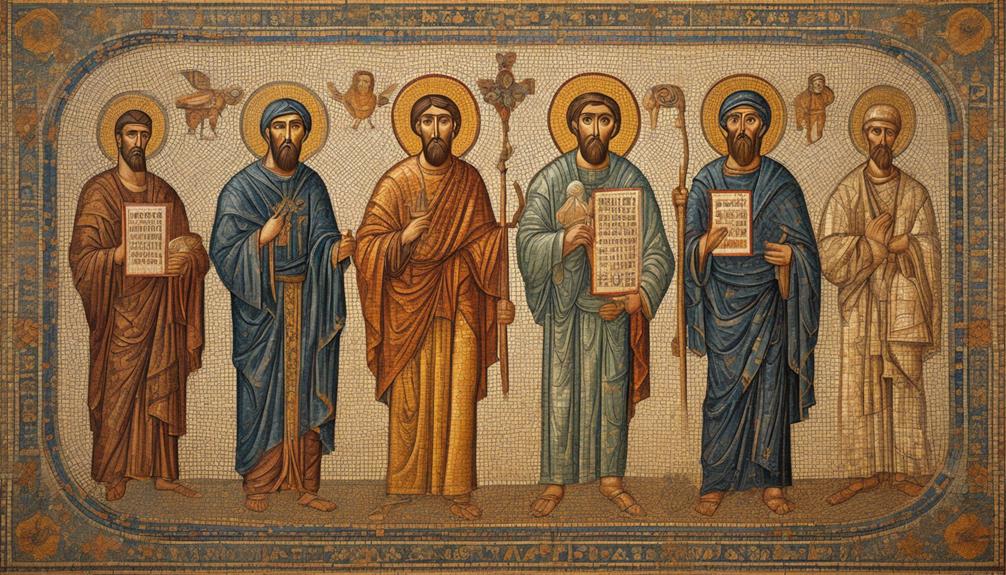
Let's talk about how Byzantine art has influenced the Orthodox Church and its liturgical practices.
The intricate and symbolic art of the Byzantine Empire has left a lasting impact on the visual representation of Orthodox Christianity.
Additionally, the liturgical practices of the Byzantine tradition have played a crucial role in shaping the rituals and worship of the Orthodox Church.
Byzantine Art Impact
The impact of Byzantine art on Orthodox culture and religious practices is profound and far-reaching. Byzantine art has deeply influenced our cultural identity, shaping our artistic expression and religious iconography. This influence can be seen in:
- Iconography: Byzantine art laid the foundation for the iconic religious imagery that's central to Orthodox worship and spirituality.
- Architectural Style: The grandeur and intricate design of Byzantine architecture continue to inspire the construction of Orthodox churches and monasteries.
- Liturgical Art: The use of rich colors, intricate patterns, and religious symbolism in Byzantine art has informed the creation of liturgical art within Orthodox tradition.
- Spiritual Symbolism: Byzantine art has instilled in us a profound appreciation for the spiritual symbolism present in religious artwork, enriching our religious experiences.
Orthodox Liturgical Practices
Building upon the influence of Byzantine art on Orthodox culture and religious practices, the liturgical practices within the Orthodox tradition bear a distinct Byzantine influence. The melodic and intricate liturgical music, along with the chant traditions, contribute to the deeply spiritual and reverent atmosphere of Orthodox worship. These musical elements are integral to the ritual and sacramental practices, enhancing the experience of the Divine Liturgy and other services.
The use of Byzantine chant and hymnography creates a sense of timelessness and connects the faithful to the ancient roots of their tradition. The rituals and sacramental practices, such as the use of incense, the veneration of icons, and the elaborate vestments worn by clergy, also reflect the Byzantine influence, emphasizing the sacred and mysterious nature of Orthodox worship.
Russian Orthodox Church
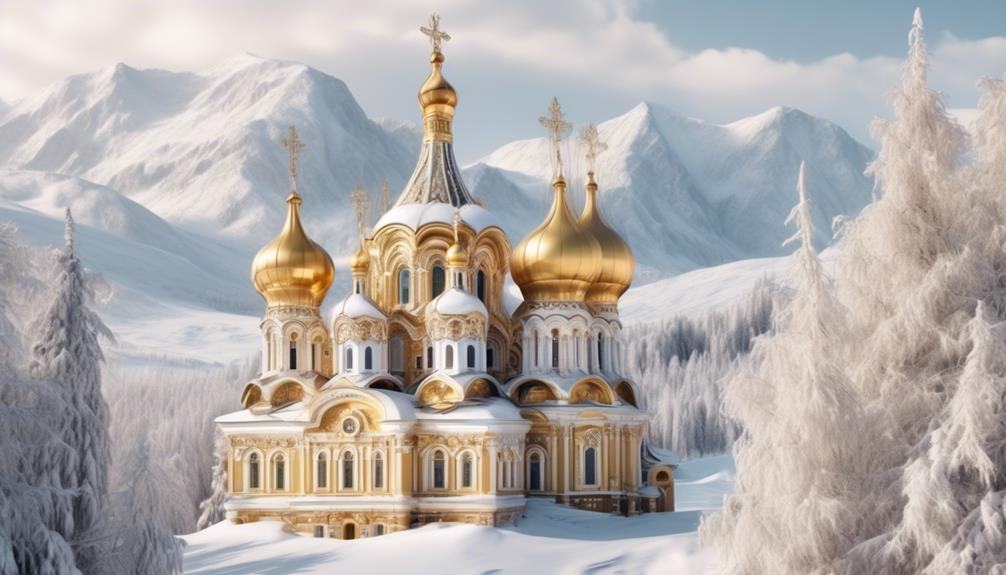
Originating in the 10th century, the Russian Orthodox Church played a significant role in shaping the religious and cultural identity of Russia. The Russian influence can be seen in the distinct architectural style of Orthodox churches, characterized by onion domes and vibrant colors, which have become iconic symbols of Russian heritage. As a part of the Russian tradition, the Orthodox Church has been deeply intertwined with the country's history, influencing art, literature, and even political events. Our connection with the Russian Orthodox Church runs deep, and it continues to be an integral part of our cultural and spiritual heritage.
- The Russian Orthodox Church has a rich history, marked by periods of both prosperity and persecution.
- Orthodox architecture, with its intricate and ornate designs, reflects the spiritual and cultural beliefs of the Russian people.
- The church plays a central role in the lives of many Russians, providing a sense of community and spiritual guidance.
- Russian Orthodox traditions, such as intricate iconography and elaborate liturgical practices, contribute to the unique identity of the church.
Spread to Eastern Europe
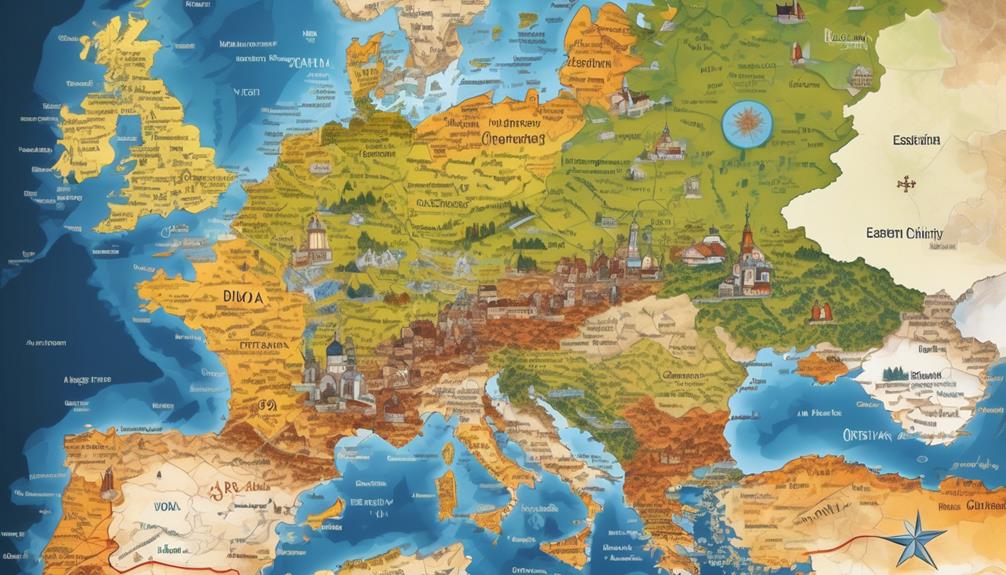
Having explored the rich history and influence of the Russian Orthodox Church, we now turn our attention to its spread to Eastern Europe.
The spread of Orthodoxy into Eastern Europe is an intricate tapestry woven with historical lineage and unbroken transmission of Apostolic succession. The Byzantine influence played a pivotal role in the expansion of Orthodox Christianity into Eastern Europe, shaping its religious and cultural landscape. The Orthodox liturgy, deeply rooted in the traditions of the Eastern Church, found its way into Eastern Europe, enriching the spiritual lives of its people.
The Great Schism of 1054, which led to the split between the Eastern Orthodox Church and the Roman Catholic Church, deeply impacted the Orthodoxy spread in Eastern Europe. The Russian Orthodox Church, with its strong monasticism tradition and Middle Eastern influence, became a significant force in propagating Orthodoxy to the Eastern European nations.
Today, modern practices in Eastern European Orthodox churches reflect a blend of historical traditions and contemporary expressions, including the iconic iconography and profound Orthodox theology that continue to characterize the faith in this region.
Monasticism and Spiritual Tradition

Monasticism and spiritual tradition hold a central place in the Eastern European Orthodox churches, shaping the daily lives and spiritual practices of their adherents.
Monasticism holds profound significance, serving as a dedicated path for individuals seeking a life of prayer, asceticism, and contemplation within the church.
Spiritual disciplines are practiced rigorously, with fasting, prayer, and meditation forming the core of monastic life, fostering spiritual growth and a deeper connection to God.
Monastic communities provide a nurturing environment, fostering a sense of communal living, where monks and nuns support each other in their spiritual journeys.
The teachings and practices of monasticism are deeply interwoven into the broader spiritual tradition of Eastern European Orthodoxy, influencing the beliefs and practices of the laity as well.
This integration of monasticism and spiritual tradition permeates the fabric of Orthodox Christianity, influencing the faithful in their pursuit of spiritual growth and communion with the divine.
Influences From the Middle East
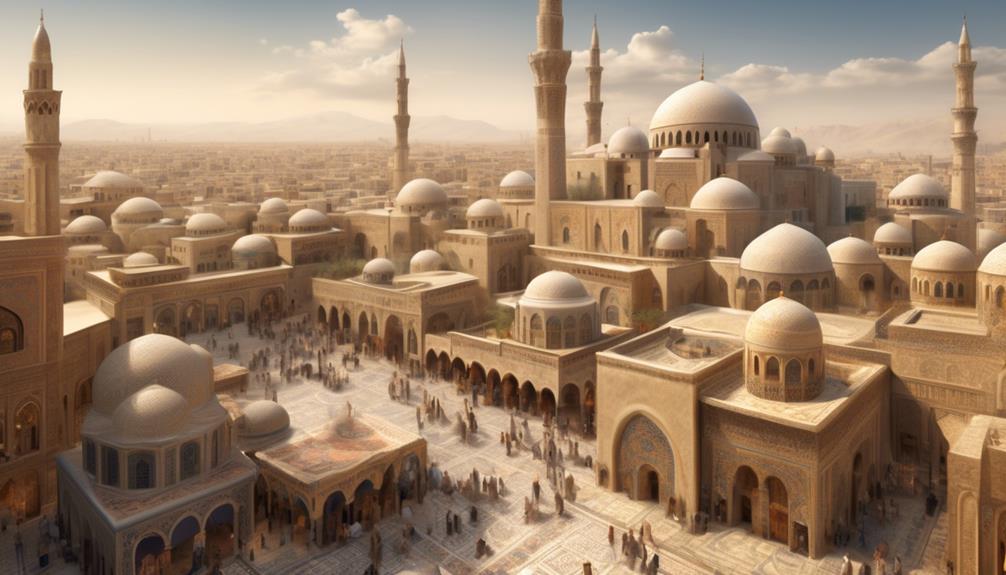
Influencing the spiritual tradition of Eastern European Orthodoxy, the Middle East has played a significant role in shaping the beliefs and practices of the faithful. Middle Eastern influences have deeply impacted the historical roots and theological development of Orthodoxy. Cultural exchange between the Middle East and Eastern Europe has enriched artistic expression, leading to the creation of mesmerizing iconography and artistry within Orthodox traditions. The liturgical practices of the Eastern Orthodox Church bear the imprint of the Byzantine influence originating in the Middle East, reflecting a connection that spans centuries.
Moreover, the Middle East holds significance in the apostolic succession of the Orthodox Church, contributing to the spiritual tradition and doctrinal controversies. As the Russian expansion reached the Middle East, diaspora communities further strengthened the ties between the regions. Today, modern challenges and ecumenical relations continue to shape the Orthodox Church, influenced by the enduring legacy of the Middle Eastern roots.
The profound impact of Middle Eastern influences on Orthodox traditions stands as a testament to the interconnectedness of diverse cultures and the enduring legacy of spiritual exchange.
Orthodox Diaspora

The Orthodox Diaspora has significantly impacted the global spread and cultural diversity of Eastern Orthodox communities. As members of these communities, we understand the profound influence of the Orthodox Diaspora on our lives and cultural integration. The following are key aspects of the Orthodox Diaspora that have shaped our communities:
- Global Spread: Our Orthodox communities have spread far and wide, crossing continents and oceans, contributing to the rich tapestry of cultural diversity in various countries.
- Cultural Integration: The Orthodox Diaspora has led to the integration of our traditions and practices with those of the countries we've settled in, enriching and diversifying our cultural heritage.
- Community Resilience: Despite facing challenges in new environments, our Orthodox communities have shown remarkable resilience, adapting to different cultures while preserving our religious and cultural identity.
- Unity in Diversity: The Orthodox Diaspora has fostered a sense of unity among diverse Orthodox communities, creating a global network of support and solidarity.
The Orthodox Diaspora continues to be a driving force in shaping the identity and cultural dynamics of Orthodox communities worldwide, creating a vibrant and interconnected global Orthodox family.
Orthodoxy in Modern Times

Let's talk about how Orthodoxy is practiced in modern times and the challenges it faces.
We'll explore the ways in which Orthodox practices have evolved to adapt to the contemporary world, as well as the ongoing issues and obstacles that the Orthodox community grapples with.
From shifts in societal norms to the impact of technology, there are many factors shaping the landscape of Orthodoxy today.
Modern Orthodox Practices
With the advent of modern technology and social changes, Orthodox practices have adapted to meet the needs of contemporary believers. Our faith community has embraced modern interpretations and evolved to address contemporary challenges.
Here are some key aspects of modern Orthodox practices:
- Embracing technology: Many Orthodox communities now utilize social media and online platforms to connect with believers and share teachings.
- Inclusivity and diversity: Efforts are being made to welcome and include individuals from diverse backgrounds, acknowledging the importance of inclusivity in modern society.
- Environmental awareness: The Orthodox community is increasingly prioritizing environmental stewardship, aligning with the contemporary focus on sustainability and ecological responsibility.
- Ethical considerations: There's a growing emphasis on addressing modern ethical dilemmas and applying Orthodox principles to contemporary issues such as bioethics and social justice.
These adaptations reflect our commitment to upholding Orthodox traditions while meeting the needs of today's world.
Challenges in Orthodoxy
Adapting to the fast-paced changes of modern society, Orthodox communities are encountering new challenges that require thoughtful navigation and innovative solutions. Modern challenges such as balancing Orthodoxy practices with contemporary issues have prompted a reevaluation of traditional approaches. The delicate task of preserving spiritual tradition while embracing evolving societal norms has become increasingly complex.
It has led to a deeper exploration of how to maintain the essence of Orthodoxy in modern times, without compromising its core values. Contemporary issues like technology, globalization, and shifting cultural dynamics have prompted introspection within Orthodox communities, fostering a dialogue on how to adapt while staying true to the essence of the faith.
Navigating these challenges involves an ongoing process of introspection and adaptation, ensuring that the timeless wisdom of Orthodoxy remains relevant in the modern world.
Iconography and Artistic Expression
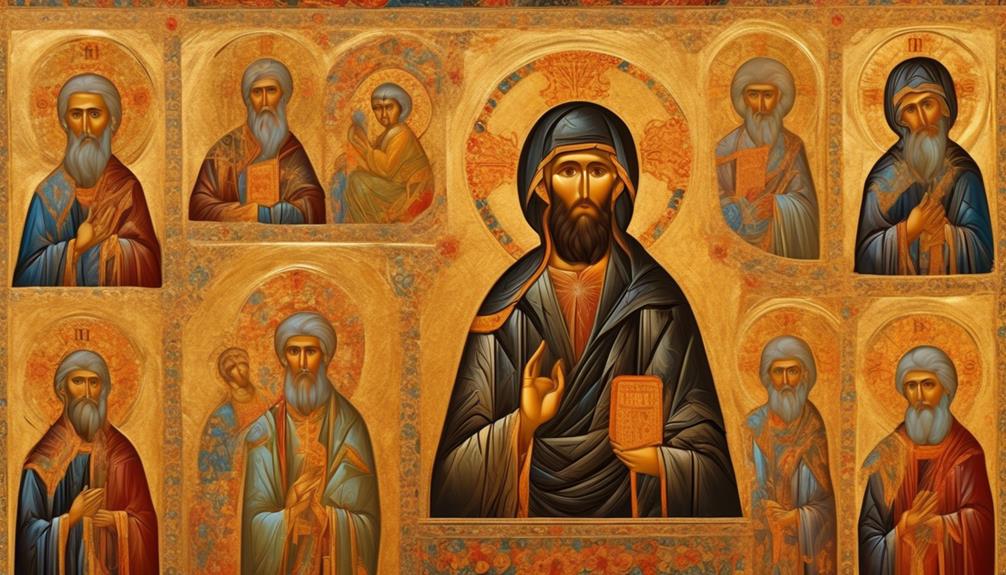
Iconography and artistic expression play a significant role in Orthodox tradition and worship, conveying spiritual truths and connecting the faithful to the divine. The Byzantine influence on religious imagery has heavily shaped Orthodox iconography, emphasizing the transcendence and otherworldly nature of the divine.
Through artistic expression, Orthodox believers encounter a rich tapestry of religious symbolism that deepens their spiritual understanding and connection to the sacred.
- Window to the Divine: Icons serve as windows to the divine, offering a glimpse into the heavenly realm and fostering a sense of awe and reverence.
- Spiritual Encounters: Artistic representations in Orthodox churches provide opportunities for spiritual encounters, enabling believers to engage with the sacred in a tangible and profound manner.
- Teaching Tool: Iconography acts as a teaching tool, conveying theological concepts and biblical narratives through visual storytelling that transcends language barriers.
- Prayer and Contemplation: Orthodox art invites individuals into a space of prayer and contemplation, facilitating a deeper communion with God and the saints depicted in the icons.
Through the intricate brushstrokes and symbolic imagery, Orthodox iconography and artistic expression continue to enrich the spiritual lives of believers, fostering a profound connection to the divine.
Liturgical Practices

The rich symbolism and spiritual significance conveyed through Orthodox iconography and artistic expression find their culmination in the liturgical practices of the faith community. In our Orthodox tradition, liturgical practices are deeply rooted in ritual symbolism and ceremonial gestures, creating a profound and immersive worship experience. These practices are infused with layers of meaning that connect us to our history, theology, and spirituality.
| Liturgical Music | Sacred Dance |
|---|---|
| Chanted hymns and psalms are integral to our worship, evoking a sense of reverence and awe. | Sacred dance, known as liturgical or religious dance, is a rare but powerful form of expression, incorporating movement into our worship. |
These practices are not merely routine, but rather serve as a means of spiritual formation and transformation, drawing us into a deeper communion with the divine. Through liturgical music and sacred dance, we are able to engage our bodies in worship, allowing the physical to become an integral part of our spiritual expression. Ritual symbolism and ceremonial gestures within our liturgical practices invite us to participate in the timeless traditions of our faith, fostering a sense of continuity and connection with the broader Orthodox community.
Orthodox Theology

Rooted in ancient tradition and theological depth, Orthodox theology shapes our understanding of God, humanity, and the world. It's a rich tapestry that weaves together centuries of wisdom and spiritual insight, informing our beliefs and guiding our spiritual journey. When exploring Orthodox theology, we encounter a beautiful blend of Eastern spirituality and a profound emphasis on the harmony between faith and reason. This unique perspective offers a holistic approach to understanding the mysteries of existence and the divine.
- Orthodox Doctrine: At the core of Orthodox theology lies a robust and unchanging set of beliefs, encapsulated in its doctrine. These foundational teachings serve as a timeless anchor amidst the ebb and flow of theological controversies.
- Theological Controversies: Throughout history, the Orthodox Church has navigated various theological controversies, contributing to the richness and depth of its theological tradition.
- Eastern Spirituality: Orthodox theology is deeply influenced by Eastern spiritual practices and perspectives, offering a unique lens through which to contemplate the divine and engage in spiritual growth.
- Faith and Reason: Orthodox theology harmoniously integrates faith and reason, recognizing the value of both in comprehending the mysteries of existence and our relationship with the divine.
Frequently Asked Questions
What Is the Significance of the Orthodox Church's Use of Icons in Worship and Religious Expression?
The significance of the Orthodox Church's use of icons in worship and religious expression is profound. Iconography is a powerful means of connecting with the divine and conveying spiritual truths.
Through icons, we experience a tangible link to the sacred and a visual representation of our faith. They serve as windows to the heavenly realm and aid in our worship by guiding our thoughts and emotions towards God.
How Do Liturgical Practices in the Orthodox Church Differ From Those in Other Christian Denominations?
Liturgical differences between Orthodox and other Christian denominations are significant. Our worship practices have a strong emphasis on tradition, ritual, and symbolism. The use of incense, icons, and chanting are integral to our worship services.
The Eucharist is central, and our liturgical calendar reflects a deep connection to the early Church. These practices create a sense of reverence and continuity that's unique to the Orthodox tradition.
What Are Some Unique Theological Beliefs or Teachings Within Orthodox Christianity That Set It Apart From Other Christian Traditions?
In Orthodox Christianity, our unique theology sets us apart from other traditions. Our emphasis on theosis, or the process of becoming more like God, distinguishes us.
The centrality of tradition and practices, such as the use of icons and the role of the liturgy, shapes our faith. These elements create a rich tapestry of beliefs and practices that are integral to our Orthodox identity.
How Has the Orthodox Church Evolved and Adapted to Modern Times, Particularly in Response to Contemporary Cultural and Social Changes?
In response to contemporary cultural and social changes, the Orthodox Church has evolved and adapted to modern times. We've embraced new technologies to spread our message and connect with believers worldwide.
While staying true to our traditions, we've also engaged in dialogue with diverse communities, fostering understanding and unity.
Our commitment to ancient teachings, combined with our willingness to engage with the present, allows us to navigate the complexities of the modern world.
What Are Some Distinct Artistic Expressions or Styles Found in Orthodox Iconography, and How Do They Reflect the Faith and Beliefs of the Orthodox Church?
Artistic expressions in Orthodox iconography showcase rich symbolic imagery reflecting our religious beliefs. These images convey profound spiritual truths and connect us to our faith.
The use of vibrant colors, intricate patterns, and specific postures in the icons all serve to deepen our understanding of Orthodox beliefs.
Through these distinct styles, we find a tangible connection to our faith, reinforcing our spiritual journey and devotion to the Orthodox Church.
What is the significance of egg cracking in the Orthodox tradition?
During the Orthodox Easter egg cracking tradition, it symbolizes the resurrection of Jesus Christ. The significance lies in the belief that cracking the egg represents breaking free from sin and entering into a new life. This symbolizes the victory over death and the promise of eternal life.
Conclusion
In conclusion, Orthodox Christianity has a rich and ancient history that dates back to the early Christian Church. Despite the Great Schism and other historical challenges, Orthodox traditions and theology have persevered.
Some may argue that Orthodoxy is outdated, but its timeless beauty and reverence for tradition create a spiritual connection that transcends time and place. It's a living, breathing expression of faith that continues to inspire and captivate believers around the world.
- About the Author
- Latest Posts
Introducing Ron, the home decor aficionado at ByRetreat, whose passion for creating beautiful and inviting spaces is at the heart of his work. With his deep knowledge of home decor and his innate sense of style, Ron brings a wealth of expertise and a keen eye for detail to the ByRetreat team.
Ron’s love for home decor goes beyond aesthetics; he understands that our surroundings play a significant role in our overall well-being and productivity. With this in mind, Ron is dedicated to transforming remote workspaces into havens of comfort, functionality, and beauty.
Chinese New Year Decorations
What Is the Symbol for Orthodox Christmas?
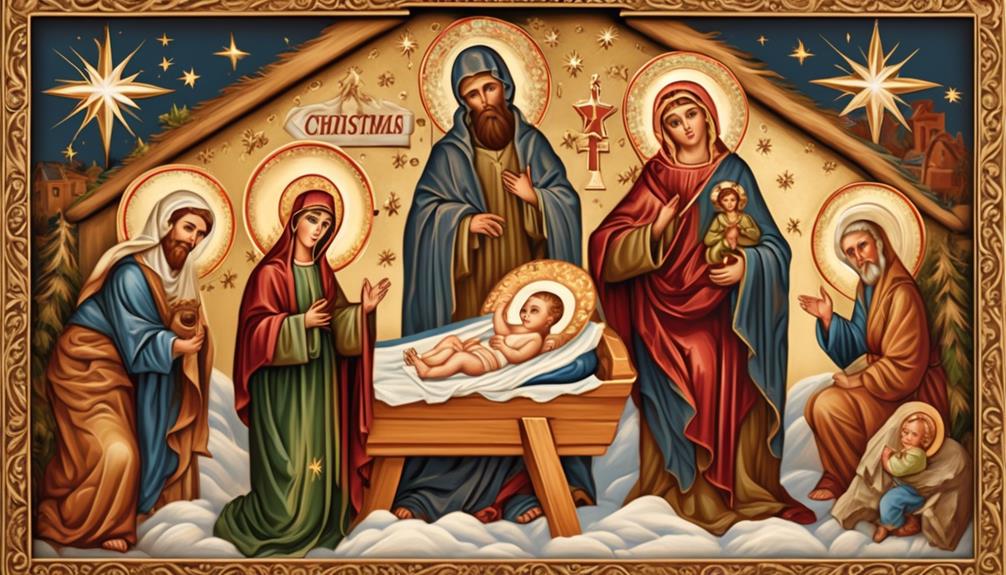
Have you ever thought about the symbol for Orthodox Christmas?
There are various theories and interpretations surrounding this topic, each shedding light on the rich cultural and historical significance behind the symbol.
As we explore the origins and meaning of this symbol, we will uncover its deep-rooted connections to Orthodox faith and its role in global celebrations.
Stay tuned to unravel the mysteries and traditions associated with this iconic symbol.
Key Takeaways
- The symbol for Orthodox Christmas is known as the Nativity icon.
- The Nativity icon represents the birth of Jesus Christ and holds profound symbolic origins.
- The icon conveys the theological truths of the Incarnation, emphasizing the divine and human nature of Jesus Christ.
- The Nativity icon is deeply embedded in the cultural fabric of many communities and represents hope, love, and the unity of families and communities during the holiday season.
Origins of the Symbol
The symbol for Orthodox Christmas, known as the Nativity icon, has its origins deeply rooted in the rich traditions and religious significance of the Eastern Orthodox Church. This iconic representation of the birth of Jesus Christ holds profound symbolic origins, reflecting the theological and spiritual beliefs of the Orthodox Christian faith. The Nativity icon isn't merely a depiction of the birth of Jesus, but it encompasses a wealth of theological meanings and spiritual significance that are central to Orthodox Christian theology.
The symbolic origins of the Nativity icon can be traced back to the early centuries of Christianity, where the visual representation of biblical events became an integral part of Christian worship and devotion. The Nativity icon, through its intricate symbolism and artistic depiction, conveys the theological truths of the Incarnation, emphasizing the divine and human nature of Jesus Christ.
It serves as a visual proclamation of the central beliefs of Orthodox Christianity, encapsulating the profound religious significance of Christmas within its sacred imagery.
Cultural Significance
Rooted in the rich traditions and religious significance of the Eastern Orthodox Church, the Nativity icon holds profound cultural significance that extends beyond its theological and spiritual meanings. The symbolic traditions associated with Orthodox Christmas are deeply embedded in the cultural fabric of many communities.
The Nativity icon, with its depictions of the birth of Jesus, not only serves as a religious symbol but also carries immense cultural weight. Its imagery is often intertwined with festive symbolism, representing hope, love, and the unity of families and communities during the holiday season.
The cultural significance of the Nativity icon is also intertwined with various religious interpretations. It serves as a visual representation of the religious narrative of the birth of Jesus, conveying the central themes of the Orthodox Christmas celebration. The icon's portrayal of the Nativity scene, along with the figures of Mary, Joseph, and the newborn Jesus, holds deep cultural and religious meaning for Orthodox Christians.
The Nativity icon, through its cultural significance and religious interpretations, continues to be a unifying symbol during Orthodox Christmas, fostering a sense of shared identity and tradition within these communities.
Symbolic Representation
Embedded in the cultural fabric and religious traditions of the Eastern Orthodox Church, the Nativity icon holds profound symbolic significance for Orthodox Christmas. Symbolic representation in Orthodox Christianity is rich and deeply rooted in tradition.
The Nativity icon, depicting the birth of Jesus Christ, is a powerful symbol that encapsulates the essence of the Orthodox Christmas. The icon is adorned with religious symbolism, portraying the Virgin Mary, the infant Jesus, the adoration of the shepherds, and the visitation of the Magi. Each element in the icon carries specific religious significance, offering a visual representation of the theological beliefs surrounding the birth of Christ.
In contrast to other Christian denominations, Orthodox symbolism often emphasizes the mystery and transcendence of divine events. The Nativity icon, through its intricate symbolism, invites believers to contemplate the spiritual truths of Christmas, fostering a deep sense of reverence and awe.
The symbolic representation in Orthodox Christmas serves as a profound reminder of the divine significance of the Incarnation, inviting believers to meditate on the sacred mysteries of the faith.
Traditional Iconography
In exploring the significance of Orthodox Christmas, the traditional iconography of the Nativity holds a pivotal role in conveying the rich symbolism and spiritual depth of this religious observance. Traditional art in Orthodox Christianity plays a profound role in depicting the Nativity, often focusing on religious symbolism to convey the divine aspects of the birth of Jesus Christ. The traditional iconography of the Nativity typically includes the Virgin Mary, the infant Jesus, and Joseph, often surrounded by shepherds, angels, and the Star of Bethlehem. Each element is meticulously crafted to symbolize profound spiritual truths and convey the significance of the event.
Comparatively, traditional iconography in Orthodox Christmas art often differs from Western Christian depictions. The emphasis on religious symbolism and the use of rich, vibrant colors in Orthodox iconography are distinctive features that set it apart. The careful attention to detail and adherence to specific artistic traditions further enhance the spiritual depth of these representations. Through traditional iconography, Orthodox Christmas art continues to serve as a powerful medium for believers to connect with the sacred narrative of the Nativity and its enduring significance.
Historical Evolution
As we explore the historical evolution of the symbol for Orthodox Christmas, it's important to consider its symbolic significance and the cultural variations that have emerged over time.
By analyzing the changes in the depiction of this symbol across different historical periods and cultural contexts, we can gain valuable insights into its evolving meaning and relevance.
Through a comparative lens, we can also examine how various traditions and interpretations have shaped the symbol's representation in diverse Orthodox communities.
Symbolic Significance
The symbolic significance of the Orthodox Christmas has evolved over centuries, reflecting a rich tapestry of historical, cultural, and religious influences. In the Orthodox tradition, symbolic representation is deeply intertwined with religious customs, each carrying profound meaning and significance. The table below provides a comparative analysis of the symbolic significance of Orthodox Christmas in various cultures and traditions.
| Symbolic Representation | Religious Custom |
|---|---|
| Nativity Icon | Fasting |
| Twelve Lenten Dishes | Midnight Liturgy |
| Yule Log | Holy Communion |
| Star of Bethlehem | Caroling |
| Angels | Epiphany |
These symbols and customs are not only a reflection of historical traditions but also serve to deepen the spiritual significance of Orthodox Christmas, providing a sense of intimacy and reverence for believers around the world.
Cultural Variations
The evolution of the symbolic significance of Orthodox Christmas is evident in the diverse cultural variations and historical influences that have shaped the celebration over time.
Cultural practices and holiday customs associated with Orthodox Christmas vary widely across different regions where it's celebrated. For instance, in some Eastern European countries, the holiday is marked with a twelve-course meatless Christmas Eve supper, while in others, it's customary to attend midnight church services.
Additionally, historical influences such as the Byzantine and Ottoman empires have contributed to the unique customs and traditions observed during Orthodox Christmas. These cultural variations highlight the rich tapestry of customs and practices that have developed over centuries, showcasing the diversity and depth of the celebration of Orthodox Christmas across different regions and communities.
Symbol's Religious Meaning
Celebrated by Orthodox Christians, the symbol of the Christmas holiday holds deep religious significance. The symbol's interpretation varies across different Orthodox Christian traditions, yet the religious significance remains central.
In the Eastern Orthodox Church, the primary symbol of Orthodox Christmas is the Nativity icon, depicting the birth of Jesus Christ in Bethlehem. This icon serves as a visual representation of the religious significance of the holiday, reminding believers of the central event in Christian theology. The Nativity icon often includes symbolic elements such as the cave where Christ was born, the manger, the Star of Bethlehem, and the presence of angels and shepherds, all of which carry profound religious meanings.
In contrast, other Orthodox traditions may emphasize different symbols, such as the Yule log in some Eastern European cultures, yet the religious significance of these symbols remains connected to the birth of Jesus Christ.
Despite variations in the symbols used to celebrate Orthodox Christmas, the religious meaning underlying these symbols serves to unite Orthodox Christians in their shared faith and devotion to the Nativity of Christ.
Regional Variations
Regional variations in the observance of Orthodox Christmas introduce diverse customs and practices that reflect the rich cultural tapestry of Orthodox Christian communities worldwide. Symbolic attire and ritual practices hold significant importance in the celebration of Orthodox Christmas, and the variations in these aspects further highlight the unique traditions within different regions.
| Region | Symbolic Attire | Ritual Practices |
|---|---|---|
| Russia | Traditional embroidered clothing, such as sarafans and kokoshniks, symbolizing the country's rich cultural heritage and history. | The Christmas Eve meal, known as Holy Supper, is a central ritual consisting of 12 meatless dishes, symbolizing the 12 apostles, and is accompanied by prayers and carol singing. |
| Greece | Garments featuring intricate designs and patterns, representing the country's deep-rooted connection to Byzantine art and religious symbolism. | The lighting of the Christmas boat, symbolizing the birth of Christ and the sea-faring traditions of the Greek people, is a significant ritual observed in coastal regions. |
| Ethiopia | White traditional garments symbolizing purity and renewal, often adorned with intricate patterns and colors. | The three-day fast, known as 'Gahad of the Fast', precedes Christmas and is followed by attending a colorful and vibrant church service on Christmas Eve. |
These regional variations not only add depth to the observance of Orthodox Christmas but also foster a sense of unity and understanding among Orthodox Christian communities around the world.
Symbol in Art and Decor
Symbolism in Orthodox Christmas art and decor plays a significant role in conveying the rich cultural and religious heritage of Orthodox Christian communities worldwide. Artistic interpretations often feature religious motifs such as the Nativity scene, depicting the birth of Jesus Christ, and the Adoration of the Magi, symbolizing the visit of the Three Wise Men. These artistic representations aren't only decorative but also carry deep spiritual significance, reminding believers of the core tenets of their faith.
Additionally, decorative symbolism in Orthodox Christmas art frequently includes elements like the use of gold and silver, symbolizing the divine and eternal nature of Christ, and the presence of angels, symbolizing the messengers of God who announced the birth of Jesus.
Comparatively, Orthodox Christmas art and decor may differ in style and specific symbols based on regional traditions and cultural influences. For example, in Eastern Orthodox traditions, icons are a prominent feature, serving as a form of religious art that holds deep symbolism and spiritual meaning. In contrast, Western Orthodox communities may incorporate different artistic styles and decorative symbols, reflecting their unique cultural expressions while still honoring the universal significance of the Christmas story.
Contemporary Interpretations
In exploring contemporary interpretations of Orthodox Christmas art and decor, we find that new expressions continue to reflect the rich cultural and religious heritage while embracing modern influences. Today, there's a growing trend of blending traditional Orthodox Christmas symbols with modern relevance. Artists and designers are infusing classic icons like the Nativity scene, the star of Bethlehem, and the cross with contemporary elements to resonate with today's audience.
Contemporary interpretations of Orthodox Christmas art often incorporate minimalist and abstract approaches, symbolizing simplicity and universality. This allows the art to be more inclusive and relatable to a broader audience, transcending cultural and religious boundaries. Moreover, there's an emphasis on sustainability and eco-friendly materials, reflecting a modern concern for environmental consciousness.
In the realm of decor, there's a shift towards sleek and modern designs that complement a variety of interior styles. Traditional colors such as gold, deep red, and forest green are being paired with neutrals and metallic accents, creating a harmonious blend of classic and contemporary aesthetics. This fusion of old and new ensures that Orthodox Christmas remains deeply rooted in tradition while resonating with the modern world.
Symbol in Orthodox Celebrations
Orthodox Christmas celebrations incorporate a myriad of symbols that reflect the rich spiritual and cultural significance of the holiday. Symbolic imagery plays a central role in these celebrations, conveying profound religious meanings and connecting participants to centuries-old traditions. Some of the most prominent symbols include:
- Nativity Iconography: Orthodox Christmas is often depicted through intricate and symbolic iconography, portraying the birth of Christ and the adoration of the Magi. These icons serve as a visual representation of the divine mystery of the Incarnation.
- Candlelight: The use of candles during Orthodox Christmas symbolizes the light of Christ illuminating the world, bringing hope and dispelling darkness. Candles are lit during religious services and in homes, creating a warm and reverent atmosphere.
- Traditional Foods: Festive customs are deeply intertwined with Orthodox Christmas celebrations, with special foods like kutia, a wheat berry pudding, and pirozhki, a type of pastry, holding symbolic meanings of prosperity, unity, and the sweetness of life.
These symbolic elements enrich the Orthodox Christmas experience, fostering a sense of spiritual connection and cultural continuity. The interplay of symbolic imagery and festive customs creates a deeply meaningful and immersive celebration.
Symbol's Global Recognition
The symbol of Orthodox Christmas holds cultural significance that extends beyond religious traditions and festive decorations. Understanding its global recognition allows for a comparative analysis of the ways different cultures and regions incorporate this symbol into their celebrations.
Cultural Significance
Symbolizing the cultural richness and spiritual significance of Orthodox Christmas, the symbol holds a global recognition that transcends borders and unites diverse communities in celebration. The symbolic interpretations and cultural variations of the Orthodox Christmas symbol reflect the unique practices and beliefs of different regions, fostering a sense of unity among Orthodox Christians worldwide.
Whether it's the festive decorations adorning homes and churches or the religious traditions observed during this time, the symbol serves as a unifying emblem that connects people across continents. Its ability to evoke a deep sense of reverence and joy makes it an integral part of the collective consciousness, transcending language barriers and cultural differences.
This universal recognition underscores the symbol's profound impact on the global celebration of Orthodox Christmas.
Religious Traditions
Amidst the global celebration of Orthodox Christmas, the symbol's universal recognition underscores its profound impact on religious traditions worldwide.
Religious practices and holiday customs vary significantly between different cultures and regions. The symbol for Orthodox Christmas serves as a unifying emblem across diverse religious traditions, symbolizing hope, peace, and the spirit of giving. Its recognition transcends geographical boundaries, resonating with believers and non-believers alike, fostering a sense of shared humanity and spiritual interconnectedness.
Comparatively, the symbol's global recognition highlights the common threads that run through various religious traditions, emphasizing the universal values of love, compassion, and unity.
As we celebrate this joyous occasion, it's essential to acknowledge the symbol's role in bridging cultural divides and promoting understanding and respect for diverse religious traditions.
Festive Decorations
As we explore the topic of festive decorations for Orthodox Christmas, it's intriguing to consider the global recognition of the symbol and its profound impact on religious traditions worldwide.
Festive ornaments play a pivotal role in celebrating Orthodox Christmas, enriching holiday traditions with vibrant colors and meaningful symbols.
When comparing festive decorations for Orthodox Christmas with those of other religious holidays, we find that each tradition holds its unique significance and beauty.
The use of traditional elements such as evergreen wreaths, candles, and nativity scenes creates a sense of unity and continuity across different cultures.
These decorations serve as a powerful reminder of the shared values and beliefs that bring people together during this joyous season, transcending geographical and cultural boundaries.
Importance in Orthodox Faith
Orthodox Christmas holds significant importance in the Orthodox faith, symbolizing the birth of Jesus Christ and serving as a time of spiritual reflection and celebration for believers. The symbolic imagery of the birth of Christ holds deep religious significance, reminding Orthodox Christians of the central event in Christian theology. It's a time when iconographic representations of the Nativity are prominently displayed, emphasizing the spiritual importance of this event in the life of believers. The birth of Jesus is seen as the fulfillment of prophecies and the manifestation of God's love and mercy to humanity.
In the Orthodox faith, the celebration of Christmas isn't just a historical remembrance but a deeply spiritual occasion. It serves as a reminder of the profound theological implications of the Incarnation, signifying God becoming human to redeem mankind. This event is a source of great joy and hope for Orthodox Christians, as it represents the divine intervention in the world. The birth of Christ is a transformative event that holds immense significance in the Orthodox faith, shaping the beliefs and practices of its followers.
Frequently Asked Questions
How Do Orthodox Christians Typically Incorporate the Symbol of Christmas Into Their Daily Lives and Routines?
Incorporating the symbol of Christmas into our daily lives and routines is a deeply meaningful tradition for Orthodox Christians.
The cultural significance of festive decorations and family traditions holds great importance.
We often adorn our homes with symbolic decorations like the nativity scene, icons, and evergreen branches as a way to honor and celebrate the birth of Jesus Christ.
These traditions create a sense of warmth, togetherness, and spiritual significance in our daily lives.
Are There Any Specific Rituals or Customs Associated With the Symbol of Orthodox Christmas That Are Not Mentioned in the Article?
Specific rituals and customs associated with Orthodox Christmas symbolize the rich cultural heritage and spiritual significance. From traditional food and drinks to festive decorations, these customs honor the historical origins and spiritual meanings.
Artistic representations also play a significant role in celebrating Orthodox Christmas, bringing the community together in joyous family gatherings and lively community events.
It's fascinating how these customs and celebrations have evolved over time, reflecting the enduring traditions and values.
What Materials or Colors Are Traditionally Used to Create or Depict the Symbol of Orthodox Christmas?
Traditionally, materials like wood, straw, and fabric in earthy tones like brown and green are used to create or depict the symbol of Orthodox Christmas. The symbolism behind these materials and colors reflects the humble and natural origins of the holiday.
While traditional practices emphasize simplicity and authenticity, contemporary adaptations may incorporate modern materials and a wider color palette.
Are There Any Specific Prayers or Blessings Associated With the Symbol of Orthodox Christmas?
When it comes to the symbolic significance of Orthodox Christmas, there are specific prayers and blessings associated with the holiday traditions. These prayers hold deep spiritual significance and are an integral part of the festive decorations.
They evoke a sense of reverence and gratitude, adding a layer of spiritual depth to the celebrations. The prayers and blessings serve as a reminder of the sacred and joyous nature of the holiday.
How Has the Symbol of Orthodox Christmas Been Influenced or Adapted in Modern Times?
In modern times, the symbol of Orthodox Christmas has been notably influenced by media and commercialization. We've seen an increase in the portrayal of Orthodox Christmas symbols in movies, advertisements, and social media, which has contributed to a broader awareness and understanding of the holiday.
However, this increased visibility has also led to the commercialization of the symbol, with many products and promotions using Orthodox Christmas imagery for profit.
Is the Symbol for Orthodox Christmas the Same as the Greeting for Coptic Christmas?
Yes, the symbol for Orthodox Christmas is the same as the greeting for Coptic Christmas. “Joyful Nativity” is traditionally used as the coptic Christmas greeting custom, and it also represents the birth of Jesus in the Orthodox tradition. Both use this symbol to celebrate the holiday.
Conclusion
In conclusion, the symbol for Orthodox Christmas stands as a beacon of hope and tradition, guiding believers through the ages with its rich cultural significance and deep-rooted symbolism.
Like a shining star in the night sky, it represents the enduring faith and spiritual journey of the Orthodox community, illuminating the path towards divine celebration and joyous festivities.
Its global recognition and importance in Orthodox faith continue to make it a cherished and revered emblem of Christmas.
- About the Author
- Latest Posts
Introducing Ron, the home decor aficionado at ByRetreat, whose passion for creating beautiful and inviting spaces is at the heart of his work. With his deep knowledge of home decor and his innate sense of style, Ron brings a wealth of expertise and a keen eye for detail to the ByRetreat team.
Ron’s love for home decor goes beyond aesthetics; he understands that our surroundings play a significant role in our overall well-being and productivity. With this in mind, Ron is dedicated to transforming remote workspaces into havens of comfort, functionality, and beauty.
Chinese New Year Decorations
What Is the Greeting for Coptic Christmas?
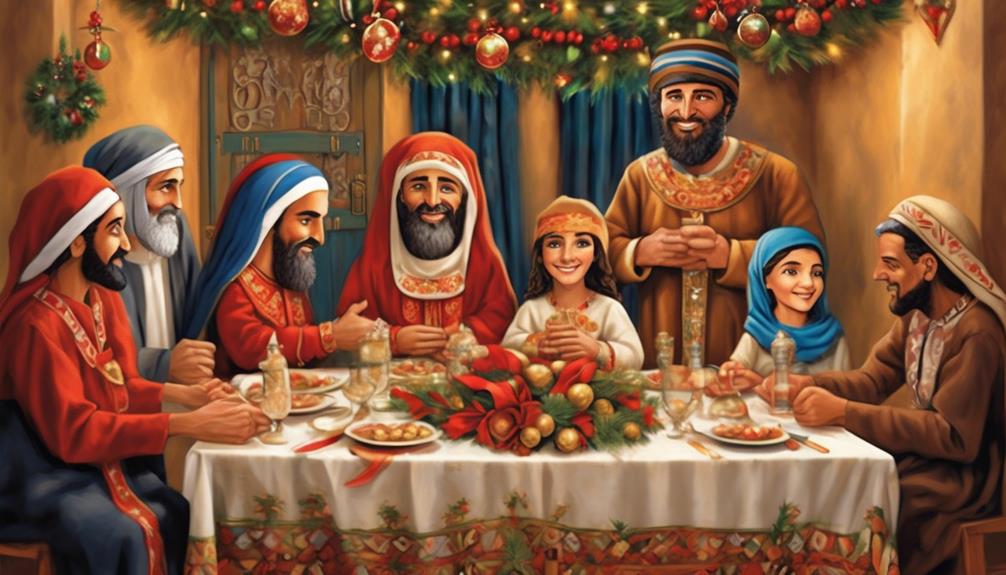
Have you ever wondered about the unique greeting for Coptic Christmas amidst the diverse range of greetings exchanged during the holiday season?
It's a tradition that holds deep cultural significance and carries a special message.
Understanding the origins and meaning behind this greeting can provide valuable insights into the rich tapestry of Coptic Christmas traditions.
Join me as we uncover the mystery behind this heartfelt greeting and its importance in the celebrations.
Key Takeaways
- The Coptic Christmas greeting holds deep cultural and religious significance for the Coptic Orthodox community.
- It plays a pivotal role in connecting individuals within the community and symbolizes the unity and shared celebration of faith and tradition.
- The greeting reflects the rich history and heritage of the Coptic community, embodying themes of love, peace, and unity.
- It fosters a sense of community and belonging, strengthens cultural identity, and forms the foundation of the Coptic Christmas festivities.
Significance of Coptic Christmas Greeting
The Coptic Christmas greeting holds deep cultural and religious significance for the Coptic Orthodox community, signifying the joyous celebration of the birth of Jesus Christ. Beyond its religious importance, this greeting plays a pivotal role in connecting individuals within the community, spreading joy and fostering social connections. It's not just a simple exchange of words; it's a heartfelt expression that transcends generations, binding the community together in a shared celebration of faith and tradition.
The greeting is a symbol of cultural importance, passed down through centuries, and is deeply ingrained in the fabric of Coptic society. As we exchange this greeting, whether with family, friends, or fellow church members, we aren't only acknowledging the birth of Jesus Christ but also reinforcing the bonds that tie us together. This simple yet profound gesture carries the weight of tradition and the warmth of shared beliefs, making it a powerful tool for cultivating a sense of unity and belonging.
In essence, the Coptic Christmas greeting goes beyond mere words; it's a conduit for spreading joy and strengthening social connections within the Coptic Orthodox community, embodying the profound significance and cultural richness of this festive tradition.
Origins of the Coptic Christmas Greeting
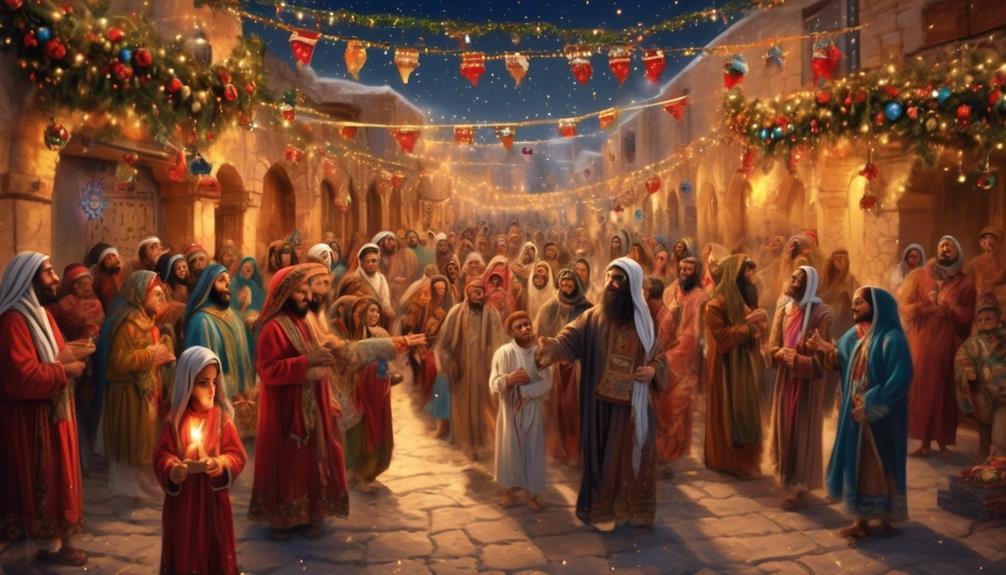
Centuries ago, our ancestors in the Coptic Orthodox community crafted a heartfelt and enduring Christmas greeting that continues to resonate with deep cultural and religious significance today. The origins of the Coptic Christmas greeting can be traced back to the early days of Christianity in Egypt, where it evolved over time to become an integral part of Coptic cultural and religious practices. This greeting has not only survived but has also evolved, adapting to the changing cultural and religious landscape while retaining its core symbolism and meaning. The evolution of the greeting reflects the rich cultural tapestry of the Coptic community and symbolizes the enduring faith and resilience of its people. The table below summarizes the cultural and symbolic significance of the Coptic Christmas greeting:
| Cultural Significance | Symbolism | Evolution |
|---|---|---|
| Deeply rooted in Coptic tradition and community | Represents the enduring faith and resilience of the Coptic people | Adapted to changing cultural and religious landscapes |
The greeting serves as a powerful reminder of the enduring traditions and beliefs that have been passed down through generations, embodying the rich heritage of the Coptic Orthodox community.
Traditional Coptic Christmas Greeting
Crafting a traditional Coptic Christmas greeting involves weaving together cultural and religious symbolism to convey heartfelt wishes and blessings. This greeting is deeply rooted in cultural tradition, reflecting the rich history and heritage of the Coptic community. It's a time-honored expression of joy and goodwill, embodying the spirit of festive celebrations.
The traditional Coptic Christmas greeting encapsulates the essence of the holiday season, encompassing themes of love, peace, and unity. It serves as a heartfelt expression of good wishes, not only for the recipient but for their entire family and community. Through this greeting, we extend warm regards and blessings, acknowledging the significance of this joyous occasion.
Embracing the traditional Coptic Christmas greeting is a cherished practice that fosters a sense of togetherness and belonging within the community. It serves as a reminder of the enduring customs and values that have been passed down through generations, enriching the festive celebrations with profound meaning and significance.
This timeless gesture embodies the essence of the holiday, uniting us in shared joy and goodwill.
Cultural Importance of Greeting in Coptic Christmas

Observing the cultural importance of greeting in Coptic Christmas, we find a tradition deeply intertwined with the fabric of community and heritage. The exchange of greetings during Coptic Christmas is not just a formality; it is a reflection of the cultural traditions and festive celebrations that have been passed down through generations. The act of exchanging greetings brings people together, fostering a sense of belonging and unity within the community. It serves as a reminder of the shared values and beliefs that form the foundation of the Coptic Christmas festivities.
| Cultural Traditions | Importance |
|---|---|
| Exchange of Greetings | Reflects shared values and beliefs |
| Festive Celebrations | Fosters sense of community and belonging |
| Heritage | Strengthens cultural identity |
Spreading Joy With Coptic Christmas Greetings
Spreading joy with Coptic Christmas greetings enhances our sense of community and strengthens our cultural identity. As we exchange these heartfelt greetings, we not only express our joy for the festive season but also foster a deeper connection with our community. Here's how spreading Coptic Christmas greetings can truly bring joy and strengthen cultural exchange:
- Building Bridges: Greetings create an opportunity for cultural exchange, allowing us to share the beauty of our traditions with others.
- Fostering Unity: By spreading joy through greetings, we reinforce a sense of togetherness and solidarity within our community.
- Preserving Traditions: Sharing Coptic Christmas greetings helps preserve our rich cultural heritage and ensures that our traditions continue to thrive.
- Creating Memories: These greetings become cherished memories, adding to the joyful atmosphere of the holiday season for both the sender and the recipient.
- Spreading Happiness: The simple act of exchanging heartfelt greetings spreads happiness and uplifts the spirits of everyone involved, creating a warm and festive atmosphere.
Exchanging Well-Wishes on Coptic Christmas

Exchanging well-wishes on Coptic Christmas brings joy and strengthens our sense of community and cultural identity. It's a time when we come together to exchange blessings and share joy, upholding cherished holiday traditions and cultural rituals. The simple act of wishing someone well on this special day fosters a deeper connection and reinforces the bonds of our community.
As we exchange heartfelt greetings and blessings with family, friends, and even strangers, we're reminded of the beauty of our shared heritage and the warmth of our cultural traditions.
These well-wishes serve as a reminder of the values and principles that unite us, filling our hearts with a sense of belonging and togetherness. Through this exchange, we not only spread joy but also honor the rich tapestry of our cultural identity. It's a beautiful way to celebrate Coptic Christmas, reaffirming our ties to one another and expressing our shared hopes for peace, prosperity, and goodwill.
In these moments of connection and celebration, we find strength and comfort in the embrace of our community, fostering a sense of unity that transcends time and distance.
The Meaning Behind Coptic Christmas Greeting
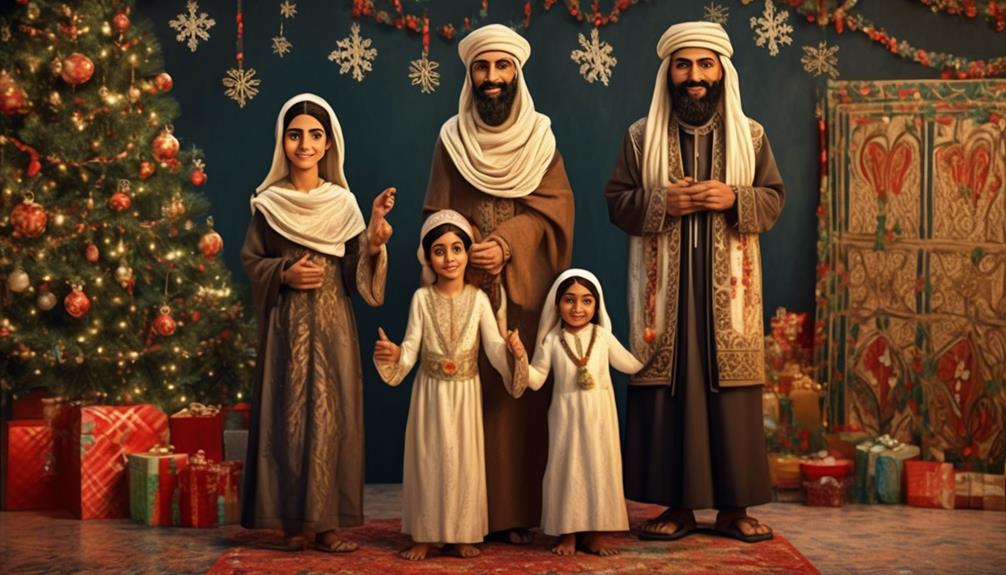
So, let's talk about the meaning behind Coptic Christmas greetings.
The tradition of exchanging well-wishes on Coptic Christmas holds great cultural significance within the Coptic Christian community.
Understanding the deeper meaning behind these greetings can provide insight into the values and beliefs cherished by individuals celebrating this special occasion.
Coptic Christmas Greeting Tradition
The Coptic Christmas greeting tradition holds deep significance within the Coptic Orthodox community, embodying a message of joy, peace, and spiritual renewal. This tradition is a beautiful reflection of our cultural importance and the unity it fosters among us.
Here's why this tradition is so meaningful:
- Spreading Joy: The greetings exchanged during Coptic Christmas are a way of spreading joy and warmth among our community members.
- Well Wishes: It's a time for us to convey heartfelt well wishes for the holiday season and the year ahead.
- Cultural Significance: The tradition reinforces our cultural identity and strengthens our bond as a community.
- Social Connections: It provides an opportunity to strengthen social connections and build camaraderie.
- Unity: By exchanging these greetings, we reinforce the sense of unity and togetherness that's integral to our faith and heritage.
Cultural Significance of Greeting
Celebrating Coptic Christmas through the traditional greeting holds deep cultural significance, embodying the spirit of joy, unity, and spiritual renewal within the Coptic Orthodox community.
The greeting 'El Milad Majid' reflects the cultural traditions and holiday customs of the Coptic Christmas, signifying the birth of Jesus Christ. It serves as a symbol of solidarity, love, and respect among Coptic Christians, fostering a sense of belonging and togetherness during this sacred time.
The exchange of this greeting is a cherished ritual that reinforces the shared values and beliefs of the community, reinforcing the importance of faith and tradition. It's a beautiful expression of the rich cultural heritage and religious devotion that characterize the Coptic Christmas celebration, connecting individuals in a profound and meaningful way.
Coptic Christmas Greeting Customs
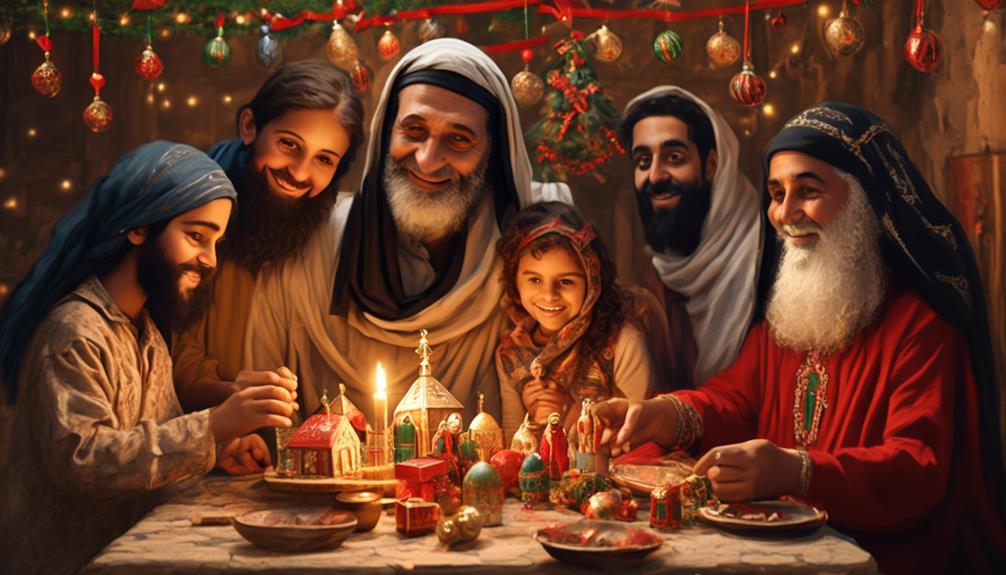
We'll explore the traditional and modern customs of Coptic Christmas greetings.
From the heartfelt traditional greetings passed down through generations to the innovative ways of expressing holiday wishes in today's digital age, Coptic Christmas greetings have evolved with time.
Understanding these customs provides insight into the rich cultural traditions surrounding Coptic Christmas celebrations.
Traditional Coptic Greetings
During the Coptic Christmas season, it's customary to exchange traditional greetings that convey blessings and well-wishes for the occasion. Traditional Coptic greetings hold deep cultural significance and are an integral part of our festive celebrations. When exchanging greetings during Coptic Christmas, consider the following:
- Invoke Blessings: Use phrases such as 'Kul sana wa inta tayeb' (كل سنة و إنت طيب) which means 'May every year find you in good health' to express blessings and well-wishes.
- Embrace Tradition: Emphasize the importance of cultural traditions by using greetings like 'El Milad Majid' (الميلاد مجيد) meaning 'Glorious Birth' to honor the religious and cultural significance of the occasion.
- Share Joy: Spread happiness and joy by greeting with 'Eid Wahda' (عيد واحد) which translates to 'One feast' signifying unity and togetherness during this festive season.
- Express Gratitude: Show appreciation and gratitude by using 'Naharak Saeed' (نهارك سعيد) or 'Nahar en Naby' (نهار النبي) to convey 'Happy Day' or 'Prophet's Day' respectively.
- Spread Love: Capture the essence of love and compassion with 'El Mawlid Sameh' (المولد سعيد) meaning 'Merry Christmas' to share love and joy with others.
Modern Coptic Greetings
Modern Coptic greetings have evolved to incorporate contemporary language and expressions while still upholding the traditional values and sentiments of the occasion. In today's Coptic community, greetings for Christmas have taken on modern practices and cultural expressions that reflect the diverse and dynamic nature of the celebrants. Below is an example of how modern Coptic greetings may appear:
| English | Coptic Transliteration | Coptic Translation |
|---|---|---|
| Merry Christmas! | Colo sana wintom tieb | Happy New Year! |
| Happy Holidays! | Pi'agi ente epnevma | Blessed feast |
| Joy and peace! | Owoot en pi'agi | Joy in the feast |
These modern greetings demonstrate the fusion of traditional Coptic values with contemporary expressions, allowing for a meaningful exchange of warm wishes during the Christmas season.
Sharing Greetings in Coptic Christmas Celebrations
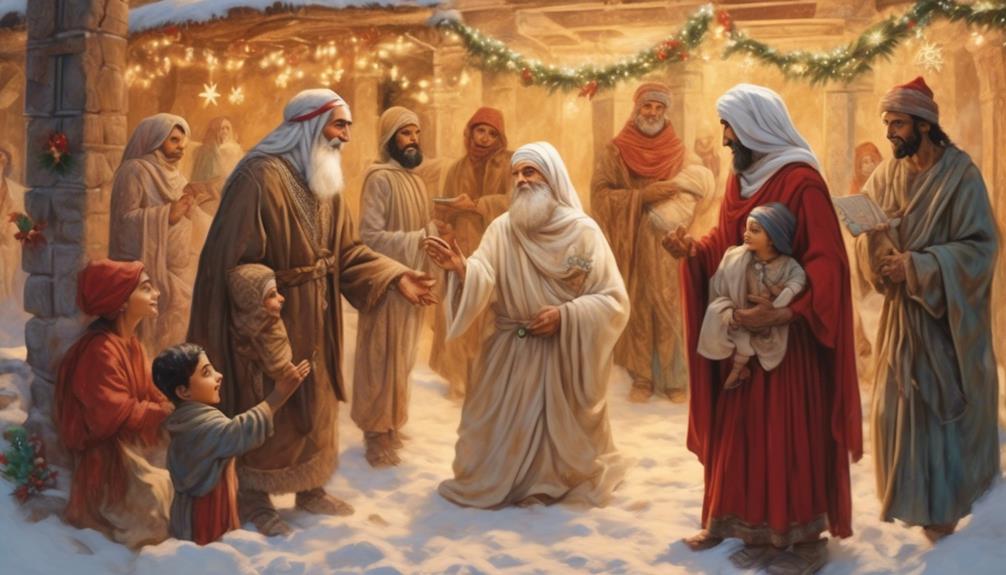
In Coptic Christmas celebrations, exchanging traditional greetings holds a special significance for the community. It's a time when we come together to share joy and blessings with one another.
Here are some key ways we share greetings during this festive time:
- 'Colo sana wintom tiebeen': This traditional Coptic greeting translates to 'May you be well every year' and is commonly used to wish others a blessed and prosperous year ahead.
- Warm Embraces: In our community, hugs and embraces are a common way to express our love and warmth towards each other during the Christmas celebrations.
- Offering Prayers: We often exchange greetings by offering prayers for each other's well-being and happiness during the Christmas season.
- Gift-giving: Sharing gifts is another way we convey our warm wishes and spread joy during the festive season.
- Festive Feasts: Coming together for communal meals and feasting is a time-honored way for us to exchange greetings and celebrate the joyous occasion.
These traditions help us create a sense of togetherness and convey our heartfelt wishes for a wonderful Christmas season.
Impact of Coptic Christmas Greetings
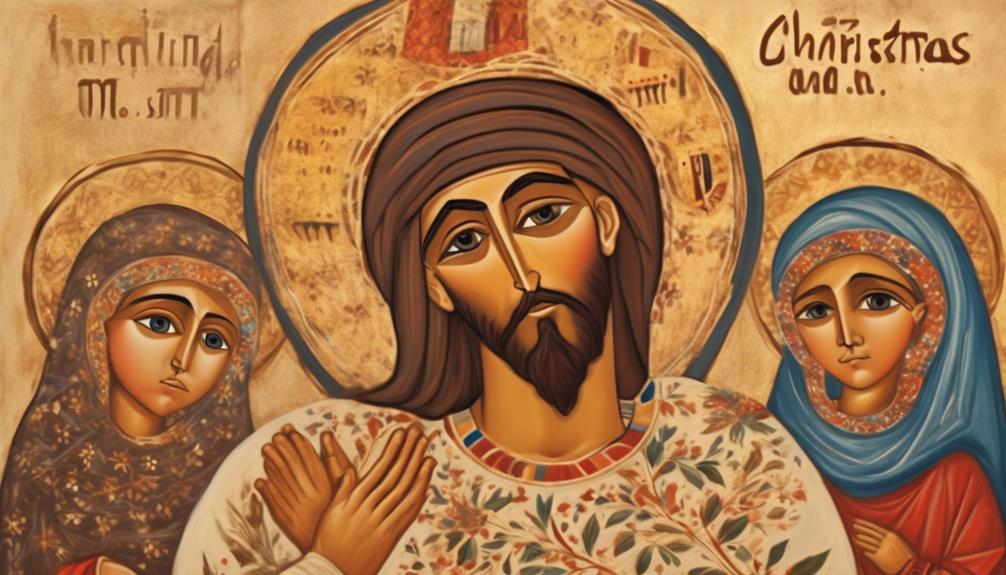
Coptic Christmas greetings carry immense cultural significance, fostering a sense of tradition and heritage within the community. These greetings also serve as a means to strengthen social connections and promote unity among Coptic Christians, creating a sense of belonging and shared identity.
Cultural Significance of Greetings
The tradition of exchanging Coptic Christmas greetings holds deep cultural significance within the Coptic community, fostering a sense of unity and connection during this important holiday. This practice reflects our cultural traditions and reinforces the bonds that tie us together as a community. The impact of Coptic Christmas greetings is substantial, as it serves as a reminder of our shared heritage and faith.
Here are some key points to consider:
- Preservation of Tradition: Greetings uphold our rich cultural heritage.
- Expression of Joy: Festive expressions convey our shared sense of joy and celebration.
- Community Bonding: Greetings strengthen our sense of community and togetherness.
- Cultural Identity: They reinforce our cultural identity and pride.
- Religious Significance: Greetings reflect our shared faith and devotion during this sacred time.
Exchanging Coptic Christmas greetings isn't just a formality; it's a meaningful expression of our shared values and beliefs.
Social Connections and Unity
Exchanging Christmas greetings within the Coptic community fosters a sense of social connection and unity, strengthening our bonds during this festive season.
These greetings serve as a foundation for social bonding, bringing us together in celebration of our shared traditions and beliefs.
When we engage in exchanging heartfelt greetings, we not only express our joy for the holiday but also affirm our belonging to the Coptic community.
This act of community engagement creates an atmosphere of warmth and togetherness, fostering a deep sense of unity among us.
By actively participating in this tradition, we reaffirm our connections to one another, building and reinforcing the strong social fabric that holds our community together.
As we extend and receive these greetings, we're reminded of the interconnectedness that defines us, enhancing the spirit of togetherness that characterizes Coptic Christmas.
Frequently Asked Questions
How Do Coptic Christians Typically Celebrate Christmas?
We typically celebrate Coptic Christmas with joyful gatherings and vibrant traditions. Our festive customs include attending church services, followed by festive meals with family and friends. We exchange gifts and enjoy traditional Coptic dishes.
The celebrations are marked by a sense of community and spiritual reflection. It's a time of togetherness and reverence, and we cherish the traditions that bring us closer to our faith and loved ones.
Are There Any Specific Foods or Dishes Associated With Coptic Christmas Celebrations?
During Coptic Christmas, our festive traditions include enjoying delicious foods like fata, a hearty dish made with rice, bread, and lamb, and kahk, sweet cookies filled with nuts and honey.
These Coptic Christmas foods are cherished by families and friends who gather to celebrate this special time. The flavors and aromas of these dishes embody the spirit of togetherness and joy during the holiday season.
What Are Some Traditional Coptic Christmas Decorations and Symbols?
For traditional decorations, we incorporate symbolic elements like the Nativity scene, known as 'The Crèche,' and images of the Holy Family.
We also adorn our homes with holly, mistletoe, and candles, symbolizing love, luck, and light.
These decorations bring warmth and joy to our celebrations, creating a festive and meaningful atmosphere for Coptic Christmas.
Is There a Specific Date or Time When Coptic Christmas Greetings Are Exchanged?
There isn't a specific date or time for exchanging Coptic Christmas greetings, as it varies depending on regional customs and individual preferences. The greetings hold immense cultural significance and are often exchanged during the Coptic Christmas Eve celebration on January 6th. However, regional variations exist, and some may exchange greetings on January 7th, the official Coptic Christmas Day.
The greetings reflect the warmth and joy of the festive season.
Are There Any Regional Variations in the Way Coptic Christmas Is Celebrated and Greeted?
In terms of regional variations and cultural differences, Coptic Christmas is celebrated and greeted in various ways.
Different regions may have unique traditions, foods, and customs surrounding the holiday.
These variations add richness and diversity to the overall celebration.
It's fascinating to see how people from different backgrounds come together to celebrate this special occasion, each bringing their own unique touch to the festivities.
How Do Coptic Christians Greet Each Other on Christmas?
During Christmas, Coptic Christians greet each other with the traditional Arabic greeting “Eid Milad Majid,” which means “Glorious Birth Feast.” Families gather for a festive meal, exchanging gifts, and decorating with unique Christmas trees, as they celebrate the joyous occasion.
Conclusion
In conclusion, the Coptic Christmas greeting is a cherished tradition that brings joy and unity to the community.
Like a warm embrace on a cold winter's day, the Coptic Christmas greeting spreads love and goodwill among family and friends, strengthening the bonds of faith and culture.
It's a simple yet powerful gesture that reflects the true spirit of the holiday season.
- About the Author
- Latest Posts
Introducing Ron, the home decor aficionado at ByRetreat, whose passion for creating beautiful and inviting spaces is at the heart of his work. With his deep knowledge of home decor and his innate sense of style, Ron brings a wealth of expertise and a keen eye for detail to the ByRetreat team.
Ron’s love for home decor goes beyond aesthetics; he understands that our surroundings play a significant role in our overall well-being and productivity. With this in mind, Ron is dedicated to transforming remote workspaces into havens of comfort, functionality, and beauty.
Chinese New Year Decorations
What Is the Christmas Tree Trend for 2023?

As the holiday season approaches, the twinkling lights and smell of pine are starting to fill our homes, indicating the arrival of Christmas.
But what can we expect for the Christmas tree trend in 2023? With sustainability and eco-consciousness on the rise, this year's tree designs are taking a fresh and innovative approach.
From minimalist and modern to vintage-inspired and nature-themed, the options seem to be evolving.
Join us as we explore the latest Christmas tree trends that are sure to captivate and inspire your holiday decorating endeavors.
Key Takeaways
- Sustainable tree farming practices continue to be a key trend in the Christmas tree industry, focusing on minimizing environmental impact and supporting local ecosystems.
- Minimalist tree designs are gaining popularity, offering simple and elegant aesthetics and space-saving solutions for downsizing holiday decor.
- Modern Christmas tree innovations are incorporating sleek aesthetics, sustainability, and space-saving features, reflecting evolving consumer demands.
- Vintage-inspired tree decor is making a comeback, with retro ornaments, classic tinsel garlands, and antique angel tree toppers adding a nostalgic ambiance and timeless elegance to modern holiday celebrations.
Sustainable Christmas Tree Options
As sustainability becomes an increasingly important consideration for consumers, the demand for eco-friendly Christmas tree options is on the rise. In response to this trend, sustainable tree farming practices are gaining traction. These practices focus on minimizing environmental impact by using organic fertilizers, natural pest control methods, and responsible land management. Sustainable tree farming not only ensures the longevity of tree populations but also supports local ecosystems.
Moreover, reusable tree stands have emerged as a popular choice among environmentally conscious consumers. These tree stands are designed to be durable and long-lasting, allowing them to be used for multiple holiday seasons. By investing in a reusable tree stand, individuals can reduce their contribution to landfill waste generated by the disposal of traditional tree stands each year.
In 2023, the shift towards sustainable Christmas tree options reflects a growing awareness of the environmental impact of holiday traditions. Consumers are actively seeking ways to celebrate the season without compromising the well-being of the planet. Sustainable tree farming and reusable tree stands offer practical and eco-friendly solutions, aligning with the values of conscientious individuals looking to make a positive impact during the holiday season.
Eco-Friendly Tree Decor
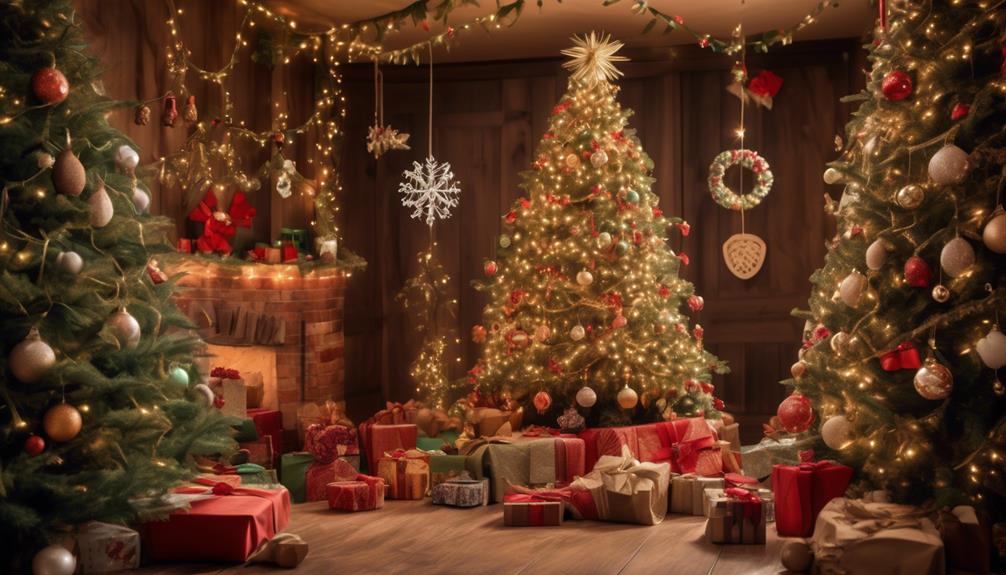
Incorporating eco-friendly tree decor not only complements the sustainable Christmas tree options trend but also enhances the overall environmentally conscious holiday experience. As experts in sustainable holiday trends, we're excited to see the growing popularity of eco-friendly tree decor.
Sustainable ornaments made from recycled materials or natural elements are becoming increasingly sought after, adding a touch of ethical charm to the festive season. These ornaments not only reduce waste but also contribute to a more eco-conscious celebration.
Additionally, eco-friendly tree skirts made from organic fabrics or upcycled materials are gaining traction. They not only provide a beautiful base for the Christmas tree but also align with the sustainability ethos.
Minimalist Tree Designs
We've noticed a rising trend in minimalist Christmas tree designs for 2023. These designs focus on simple and elegant aesthetics, with a strong emphasis on sustainability.
They offer space-saving solutions for those looking to downsize their holiday decor while still making a stylish statement.
Simple, Elegant Designs
For a timeless and sophisticated holiday look, consider opting for a minimalist Christmas tree design with clean lines and subtle decorations.
Embracing natural materials and Scandinavian elegance, this trend embodies simplicity and grace. Choose a tree with a sleek silhouette, such as a slim fir or spruce, to create an elegant focal point in your space.
Keep the color palette muted, using soft tones like white, silver, and light wood to maintain a refined ambiance. Select ornaments and lights with minimalist designs, focusing on quality over quantity.
To enhance sustainability, consider using eco-friendly materials and LED lights. By embracing simplicity and elegance, you can create a serene and stylish holiday atmosphere that exudes a sense of calm and sophistication.
Sustainable Tree Options
As we move into discussing sustainable tree options, particularly within the realm of minimalist designs, the focus on embracing natural materials and eco-friendly choices remains a key aspect of creating a timeless and sophisticated holiday ambiance.
When considering sustainable tree options for the upcoming holiday season, there are several eco-friendly choices that are gaining popularity:
- Tree Rental Services: Opting for tree rental services allows individuals to enjoy the beauty of a real tree without contributing to deforestation. It's a sustainable option that promotes the reuse of trees year after year.
- Live Potted Trees: Choosing live potted trees not only brings a touch of nature indoors but also allows for the tree to be replanted after the holiday season, making it a truly eco-friendly choice.
- DIY Minimalist Tree Designs: Crafting minimalist tree designs using natural and recyclable materials such as wood, twigs, and eco-friendly decorations can significantly reduce environmental impact while achieving a modern and sustainable holiday look.
Space-Saving Solutions
Embracing the trend of space-saving solutions, minimalist tree designs provide a stylish and sustainable option for those seeking to optimize their holiday decor in a modern and eco-friendly manner.
Space-saving storage is a key consideration for many individuals, especially those living in smaller homes or apartments. Innovative designs in minimalist trees offer a practical solution, often featuring slim profiles, collapsible structures, and wall-mounted options. These trees not only save space during the festive season but also make storage hassle-free once the holidays are over.
With a focus on simplicity and functionality, these designs cater to the growing demand for versatile and compact holiday decor. By incorporating minimalist tree designs, individuals can enjoy the festive spirit without compromising on style or sustainability, making it an ideal choice for those looking to maximize their living space.
Modern Christmas Tree Innovations

Innovation has transformed modern Christmas trees, introducing sustainable materials and space-saving designs. As experts in the field, we've been closely monitoring the latest trends and have identified the most exciting modern Christmas tree innovations for 2023.
Here's what's shaking up the traditional tree scene:
- Futuristic Tree Designs:
Embracing a sleek, minimalist aesthetic, futuristic tree designs are gaining popularity. These trees often feature unconventional materials like metal and glass, and their innovative lighting creates a mesmerizing display that captivates the eye.
- Sustainable Tree Alternatives:
In line with the growing sustainability movement, modern Christmas trees are now being crafted from eco-friendly materials such as recycled wood, cardboard, and even repurposed plastics. These sustainable alternatives not only reduce environmental impact but also add a unique, contemporary flair to holiday decor.
- Space-Saving Innovations:
Recognizing the need for practicality in today's living spaces, modern Christmas trees are being designed with compactness in mind. From wall-mounted trees to collapsible options, these space-saving innovations allow for festive celebrations without compromising on precious room real estate.
These modern Christmas tree innovations reflect the evolving demands of consumers for sustainable, space-efficient, and visually striking holiday decor.
Vintage-Inspired Tree Decor
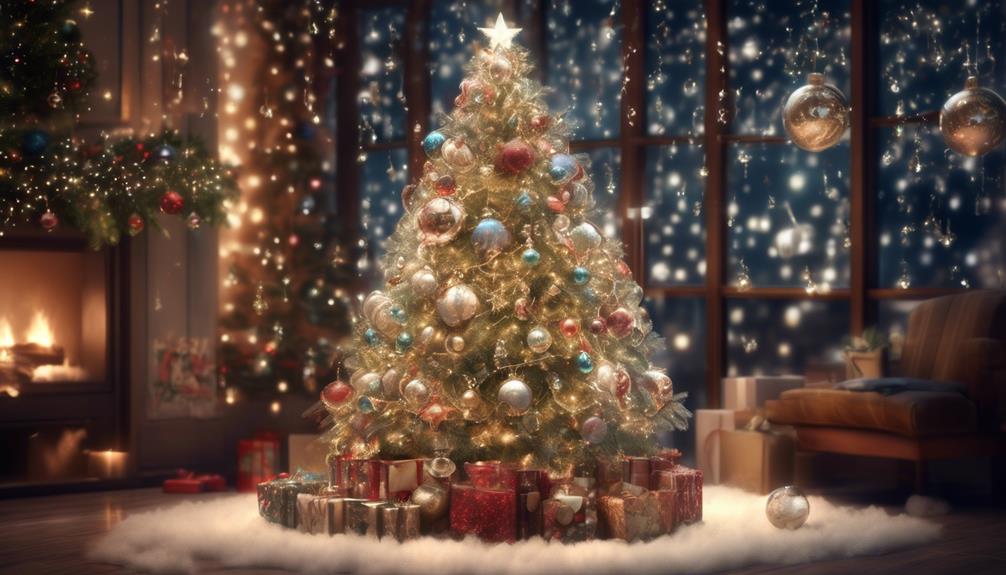
We've noticed a growing interest in vintage-inspired tree decor for the upcoming holiday season. Retro ornaments and lights, classic tinsel garlands, and antique angel tree toppers are making a comeback in a big way.
This trend not only adds a touch of nostalgia to our Christmas trees but also promotes sustainability by repurposing and reusing timeless decorations.
Retro Ornaments and Lights
Incorporating retro ornaments and vintage-inspired lights into your Christmas tree décor adds a nostalgic touch and timeless charm to your holiday celebrations. The trend for 2023 is all about embracing the classic appeal of yesteryears. Here's why you should consider incorporating retro ornaments and vintage-inspired lights:
- Nostalgic Ambiance: Retro tinsel and vintage baubles evoke heartwarming memories, creating a cozy and nostalgic ambiance in your home.
- Timeless Elegance: Vintage-inspired lights bring a timeless elegance to your tree, adding a touch of sophistication and grace to your holiday décor.
- Sustainability: Embracing retro ornaments and vintage-inspired lights aligns with sustainable practices by reusing and repurposing items, contributing to a more eco-friendly approach to holiday decorating.
With a nod to the past and a sustainable mindset, incorporating retro ornaments and vintage-inspired lights into your Christmas tree décor is the perfect way to infuse your celebrations with warmth and charm.
Classic Tinsel Garlands
Embracing classic tinsel garlands as part of your vintage-inspired tree decor infuses a timeless elegance into your holiday celebrations. Tinsel, with its shimmering strands, has made a remarkable comeback, adding a touch of nostalgia to modern holiday decor. When considering tinsel alternatives, look for sustainable options such as recycled materials or biodegradable alternatives to minimize environmental impact. Modern tree toppers like vintage-inspired angels or handcrafted starbursts beautifully complement classic tinsel garlands, enhancing the nostalgic ambiance. To evoke a sense of intimacy, we've curated a table featuring the emotional appeal of classic tinsel garlands:
| Emotion | Description | Example |
|---|---|---|
| Nostalgia | Elicits fond memories | Family heirloom tinsel |
| Warmth | Creates cozy atmosphere | Soft, glowing tinsel |
| Joy | Evokes feelings of happiness | Shimmering silver tinsel |
| Elegance | Adds a touch of sophistication | Gold-threaded tinsel |
Classic tinsel garlands not only bring traditional charm but also contribute to sustainable, eco-friendly holiday decor.
Antique Angel Tree Topper
Antique angel tree toppers are making a significant resurgence in the realm of vintage-inspired tree decor, adding a touch of timeless elegance to modern holiday celebrations. These antique angels bring a sense of nostalgia and tradition to the festive season, making them a cherished addition to any Christmas tree.
Here's why antique angel tree toppers are the latest trend for vintage-inspired decor:
- Timeless Elegance: Antique angel tree toppers exude a classic charm that elevates the overall aesthetic of the tree.
- Sentimental Value: These vintage-inspired decor pieces often carry sentimental value, evoking cherished memories and family traditions.
- Sustainable Option: Opting for antique angel tree toppers promotes sustainability by repurposing and appreciating timeless pieces, reducing the need for new decorations.
With their timeless appeal and sentimental significance, antique angel tree toppers are becoming a beloved choice for vintage-inspired holiday decor.
Creative DIY Tree Ornaments
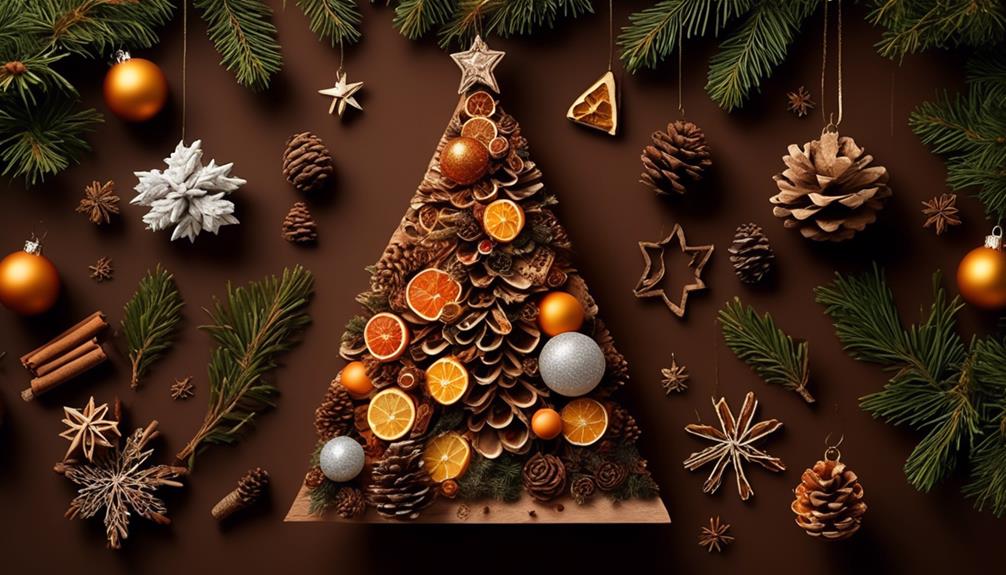
To create a unique and sustainable Christmas tree, consider crafting your own DIY ornaments using eco-friendly materials and personalized touches. DIY ornament ideas offer a perfect way to infuse your tree with creativity and reduce waste by upcycling items into beautiful decorations. Here are some inspiring ideas for DIY Christmas tree ornaments:
| Ornament | Materials Needed | How to Make It |
|---|---|---|
| Pinecone Reindeer | Pinecones, pipe cleaners, small red pom-poms, googly eyes, ribbon | Twist pipe cleaners around the pinecone to create antlers, then glue on googly eyes and pom-pom for the nose. Attach a ribbon for hanging. |
| Scrabble Tile Initials | Scrabble tiles, ribbon | Glue the Scrabble tiles together to form initials or meaningful words. Attach a ribbon for hanging. |
| Fabric Scrap Ornaments | Fabric scraps, embroidery hoops, yarn | Place fabric in the embroidery hoop, tie with yarn, and trim excess fabric. Hang with a festive ribbon. |
These DIY ornaments not only add a personal touch to your tree but also contribute to sustainability by using repurposed materials. Get creative and enjoy making these unique ornaments for a more meaningful and eco-conscious holiday season.
Tech-Integrated Tree Lighting

We've seen a surge in smart lighting options for Christmas trees, allowing for customizable displays and energy efficiency.
With voice-controlled tree lights and interactive light displays, technology is seamlessly integrated into the holiday tradition of decorating a Christmas tree.
This trend not only adds a modern touch to the festivities but also promotes sustainability through the use of energy-saving LED lights and programmable features.
Smart Lighting Options
One exciting trend in Christmas tree decorating for 2023 is the integration of smart lighting options, offering a modern and innovative approach to illuminating your tree. This trend not only brings a touch of technology to your holiday decor but also provides practical benefits such as energy efficiency and convenience.
Here are the top smart lighting options to consider for your Christmas tree:
- Energy Efficient Bulbs: Smart LED lights aren't only vibrant and customizable but also use significantly less energy than traditional incandescent bulbs, reducing your environmental impact.
- Wireless Control Options: With wireless control capabilities, you can easily adjust the brightness, color, and patterns of your tree lights using a smartphone app or voice commands, adding convenience and flexibility to your holiday decorating.
- Smart Automation Features: Some smart lighting systems offer automation features, allowing you to schedule lighting patterns or integrate them with other smart home devices for a seamless holiday experience.
Embracing smart lighting options for your Christmas tree not only enhances the aesthetics of your holiday decor but also aligns with sustainable and modern living.
Voice-Controlled Tree Lights
After exploring energy-efficient bulbs and wireless control options in smart lighting for Christmas trees, the next frontier in tree illumination is the integration of voice-controlled tree lights, marking a significant advancement in tech-integrated tree lighting for the upcoming holiday season.
With personalized lighting becoming increasingly popular, voice-activated decorations offer a seamless and hands-free way to customize the ambiance of your Christmas tree. Imagine simply speaking a command to adjust the colors, brightness, or lighting effects without the need to fiddle with switches or apps.
This innovative technology not only adds convenience but also aligns with sustainability efforts by promoting efficient energy usage. As the demand for interactive and eco-friendly holiday decor grows, voice-controlled tree lights are set to revolutionize the way we adorn and illuminate our festive trees, providing a more personalized and enchanting experience for the holiday season.
Interactive Light Displays
As we delve into the realm of tech-integrated tree lighting, interactive light displays are emerging as a captivating and sustainable trend for the upcoming holiday season. These innovative displays offer energy-efficient options, such as LED lights and programmable features, reducing environmental impact while enhancing visual appeal.
Additionally, interactive projection mapping allows for dynamic and customizable lighting experiences, creating a mesmerizing atmosphere in any space. Outdoor installations bring a touch of magic to exterior settings, engaging viewers with enchanting light shows.
Furthermore, interactive music synchronization adds an extra dimension to the displays, syncing lights with music to create a symphony of sight and sound. With these developments, interactive light displays aren't only elevating the holiday ambiance but also contributing to a more sustainable and immersive festive experience.
Customizable Tree Trends

The trend for customizable Christmas trees in 2023 reflects a growing demand for personalized and sustainable holiday decor options. Personalized ornaments and themed tree skirts are at the forefront of this trend, allowing individuals to express their unique style and values through their festive displays. This trend aligns with the increasing focus on sustainability, as it encourages the reuse of ornaments and tree skirts year after year, reducing waste and promoting mindful consumption.
Customizable trees provide a delightful opportunity for families to come together and create cherished memories while decorating. Whether it's incorporating homemade ornaments that hold sentimental value or choosing a theme that reflects a shared passion, the customizable tree trend fosters togetherness and meaningful connections during the holiday season.
Moreover, this trend promotes individuality and self-expression, empowering people to curate a holiday aesthetic that resonates with their personal tastes. By embracing customizable Christmas trees, households can infuse their spaces with warmth and character, enhancing the joy and magic of the season.
Nature-Inspired Tree Themes
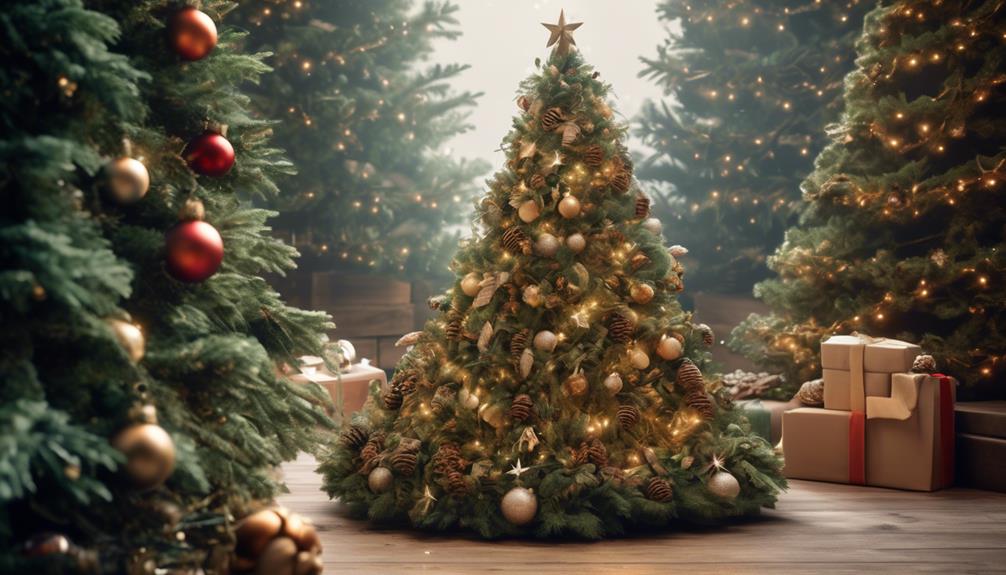
Nature-inspired tree themes offer a refreshing and sustainable approach to holiday decor, drawing inspiration from the beauty and tranquility of the natural world. Embracing botanical themed tree decorations and natural tree ornaments, this trend brings the outdoors inside, creating a sense of calm and connection with nature. Forest inspired tree designs and woodland tree decor further enhance this theme, incorporating elements like pinecones, wood slices, and earthy colors to evoke the peaceful ambiance of a forest.
Why Nature-Inspired Tree Themes Are Trending:
- Sustainability: By utilizing natural elements, this trend promotes eco-friendly practices, aligning with the growing interest in sustainable living.
- Tranquility: The use of forest-inspired designs and botanical elements creates a serene and peaceful atmosphere, offering a refreshing break from the hustle and bustle of the holiday season.
- Timelessness: Nature-inspired decorations bring a timeless elegance to holiday decor, making them a versatile choice for any home aesthetic.
Incorporating nature-inspired tree themes not only adds a touch of natural beauty to your holiday decor, but also contributes to a more sustainable and calming festive environment.
Non-Traditional Tree Alternatives
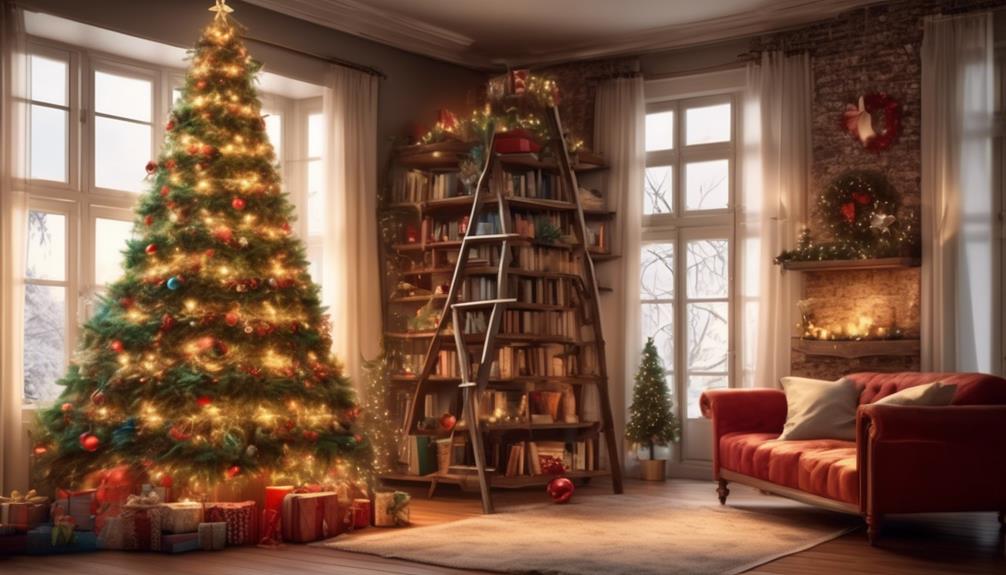
Pioneering a departure from traditional tree decor, the demand for innovative and sustainable holiday alternatives has led to a surge in interest for non-traditional tree options. Artistic tree sculptures and sustainable designs are gaining popularity as non-traditional tree art and eco-friendly installations become more sought after. These alternatives offer a fresh, modern take on the traditional Christmas tree, appealing to individuals looking for unique, environmentally conscious options.
Artistic tree sculptures are redefining holiday décor, offering a blend of artistry and festive spirit. These sculptures come in various materials, from metal to recycled wood, and can be customized to fit any space. They provide a captivating focal point for holiday gatherings, infusing the space with creativity and elegance.
Moreover, sustainable designs are making waves as eco-friendly installations take center stage. From upcycled materials to minimalist, reusable structures, these non-traditional tree alternatives cater to the environmentally conscious consumer. They not only reduce waste but also promote a more sustainable approach to holiday decorating, aligning with the growing trend of eco-conscious living.
As the demand for non-traditional tree alternatives continues to rise, the market is abuzz with innovative, sustainable options that offer a delightful departure from the conventional Christmas tree.
Timeless Classic Tree Decor
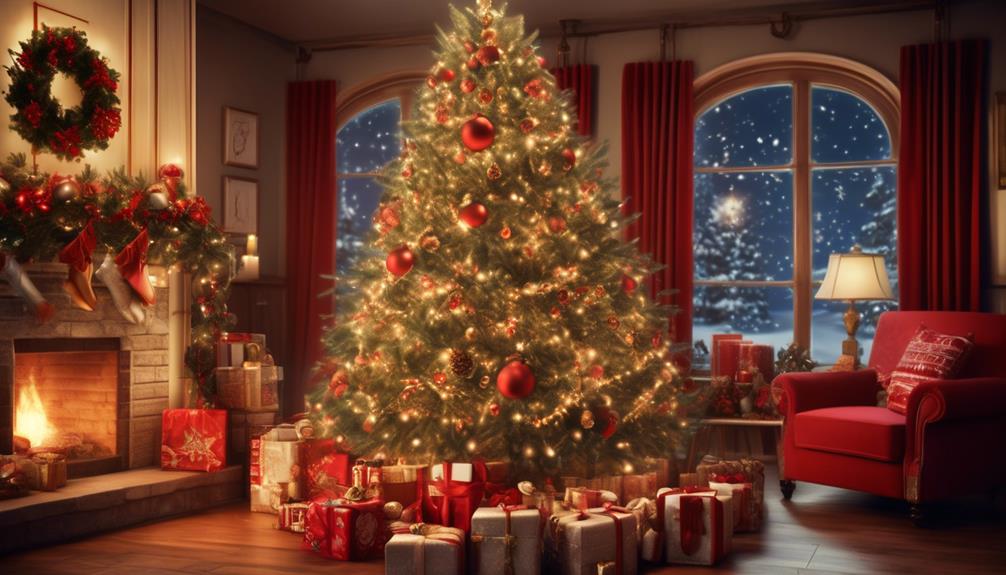
Embracing the enduring appeal of traditional tree decor, we find a timeless elegance that adds a touch of nostalgia to holiday celebrations. The classic tree decor trend for 2023 focuses on elegant simplicity and traditional charm, bringing warmth and familiarity to the holiday season.
Here are three key elements of timeless classic tree decor:
- Traditional Ornaments: Adorning the tree with heirloom ornaments, handmade crafts, and vintage baubles creates a sense of tradition and history. These timeless pieces evoke cherished memories and create a cozy atmosphere in the home.
- Warm White Lights: Opting for warm white string lights adds a soft and inviting glow to the tree, enhancing its classic and timeless appeal. These lights create an enchanting ambiance that complements the traditional charm of the decor.
- Classic Tree Topper: A traditional tree topper, such as a star, angel, or ribbon, provides a finishing touch to the tree, exuding elegance and grace. It adds a nostalgic touch and completes the overall look with a timeless flair.
Incorporating these elements into your Christmas tree decor for 2023 will infuse your home with a sense of enduring tradition and timeless beauty.
Frequently Asked Questions
How Can I Recycle My Old Artificial Christmas Tree in an Eco-Friendly Way?
When it comes to recycling an old artificial Christmas tree in an eco-friendly way, there are some great options to consider.
Upcycling ideas include turning the tree into smaller decorations or repurposing the branches for crafts.
Additionally, you could explore donation options with local organizations or schools that may be in need of holiday decorations.
It's a sustainable way to give your tree new life and spread some festive cheer.
What Are Some Ways to Incorporate Sustainable Materials Into My Christmas Tree Decorations?
We've been exploring ways to make our Christmas tree decorations sustainable.
One idea is to use eco-friendly ornaments made from recycled materials or natural elements like wood, cork, or dried citrus slices.
Another way is to incorporate natural fiber garlands, such as jute or hemp, which not only look beautiful but are also biodegradable.
These sustainable materials not only bring a cozy, rustic charm to our tree but also contribute to reducing environmental impact.
Are There Any Minimalist Tree Designs That Also Incorporate Sustainable or Eco-Friendly Elements?
Absolutely! We're seeing a rise in minimalist designs for Christmas trees that incorporate eco-friendly elements. Think sleek, unadorned trees adorned with sustainable ornaments like wooden or felt decorations, LED lights, and recycled materials.
Embracing simplicity and sustainability, these trees aren't only aesthetically pleasing but also align with eco-conscious values. It's a trend that's gaining popularity as people seek to celebrate the holidays in a more environmentally friendly way.
What Modern Innovations Are Available for Christmas Trees That Are Also Environmentally Friendly?
When it comes to modern innovations for environmentally friendly Christmas trees, we're seeing a rise in solar-powered lights and biodegradable ornaments.
This trend not only adds a touch of sustainability to the festive season but also embraces the latest technological advancements.
How Can I Create Vintage-Inspired Tree Decor Using Repurposed or Recycled Materials?
To create vintage-inspired tree decor using repurposed or recycled materials, we often start by scouring flea markets or thrift stores for unique ornaments. These repurposed ornaments add character and charm to the tree.
For a vintage DIY tree topper, consider crafting one using old lace, fabric, or even repurposed jewelry.
It's all about infusing nostalgia and sustainability into your holiday decorations, creating a timeless and eco-friendly festive ambiance.
Is the Christmas Tree Trend for 2023 available at the Biggest Christmas Store?
Yes, the Christmas Tree Trend for 2023 is indeed available at the biggest Christmas store. With a wide range of sizes, styles, and decor options, you can find the perfect tree to suit your festive vision at the biggest Christmas store.
Conclusion
As we look ahead to the Christmas tree trends for 2023, it's clear that sustainability and creativity will be at the forefront.
From eco-friendly options to minimalist designs and modern innovations, there's a trend for everyone.
Whether you're drawn to vintage-inspired decor or nature-inspired themes, there's no shortage of customizable and non-traditional alternatives to choose from.
With timeless classics making a comeback, the Christmas tree of 2023 is sure to be a reflection of individual style and eco-conscious choices.
- About the Author
- Latest Posts
Introducing Ron, the home decor aficionado at ByRetreat, whose passion for creating beautiful and inviting spaces is at the heart of his work. With his deep knowledge of home decor and his innate sense of style, Ron brings a wealth of expertise and a keen eye for detail to the ByRetreat team.
Ron’s love for home decor goes beyond aesthetics; he understands that our surroundings play a significant role in our overall well-being and productivity. With this in mind, Ron is dedicated to transforming remote workspaces into havens of comfort, functionality, and beauty.
-

 Vetted2 days ago
Vetted2 days ago15 Best Plants for Large Pots to Transform Your Outdoor Space
-

 Vetted19 hours ago
Vetted19 hours ago15 Best Fairy Lights to Transform Your Space With Magical Illumination
-

 Vetted4 days ago
Vetted4 days ago15 Best Folding Beds for Small Spaces – Space-Saving Solutions for Comfort and Convenience
-

 Vetted3 days ago
Vetted3 days ago15 Best Waterproof Flooring Options for Your Bathroom – Ultimate Guide & Reviews
-

 Vetted1 week ago
Vetted1 week ago15 Best Grocery Carts to Make Shopping a Breeze
-

 Vetted2 weeks ago
Vetted2 weeks ago15 Best Gravel for Driveway: The Ultimate Guide for a Durable and Stunning Entrance
-

 Vetted6 days ago
Vetted6 days ago15 Best Steam Generators for Showering Bliss: Reviewed & Rated
-

 Beginners Guides4 weeks ago
Beginners Guides4 weeks agoI Inhaled Vinegar Fumes

























